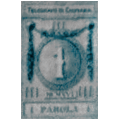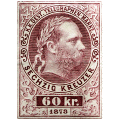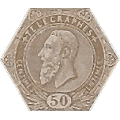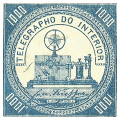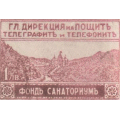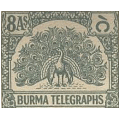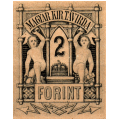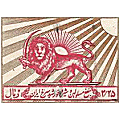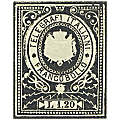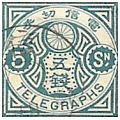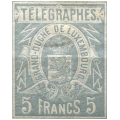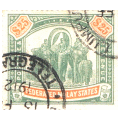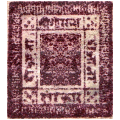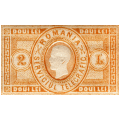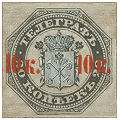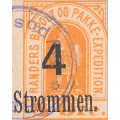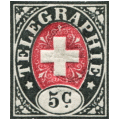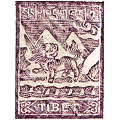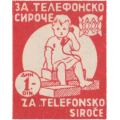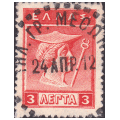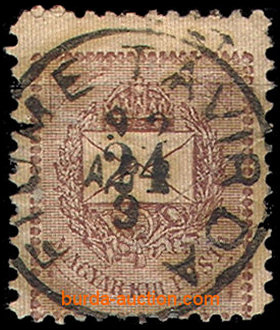| अनुवाद |
Übersetzen sie |
WORKING
|
Traduisez |
ترجم |
| перевести |
Traduca |
Traduzca |
翻译 |
|
Telegraph stamps of the World
Click here for a site-map. |
Select currency. Default = GBP (1.0)
|

I have brought these prices up to date and added currency selection.
CheckList Setup |
HUNGARY.
Steve Hiscocks wrote:
Austria and Hungary became separate in most respects, although both ruled by Franz Josef I, in 1867 and the first Hungarian postage stamps were issued in 1871. Telegraph stamps followed in 1873 as in Austria. It was ordained that these should be printed from engraved copper plates but, when it became evident that these could not be ready in time, permission was given for a temporary lithographed issue. The lithographed stamps were in use from 1 August 1873 for about a year after which they were replaced by the engraved series of exactly the same designs and values. The use of these stamps was discontinued on 28 February 1879 and forbidden thereafter. After a further nine months during which stocks in the hands of the public could be redeemed they were demoneterized and remaining stocks reportedly sold to collectors and dealers.
The lithographed stamps were all perforated 9½. The low value engraved were perforated 13 while the engraved 1 and 2 Forint at 9½ for a while but later changed to 13. The lithographed were on the same thick paper as the postage stamps while the engraved stamps were on much thinner paper. Virtually all the first issue were pen-cancelled and steel circular date stamp cancels were introduced in late 1874 and 1875.
Three official reprintings took place to illustrate various publications — 1878, 1891 and 1900. All were engraved and imperforate. Known forgeries include false ink cancellations on engraved stamps, perforated 1 Forint from the 1891 reprinting and perf.13, 1 and 2 Forint stamps reperforated 9½.
|
My note:
Known forgeries. Does anyone have information that might distinguish these ?
Thickness and colour of paper, gum if any, colour of low values would be good to know.
Checking paper and diameter of perforations against known originals may be a good idea for expensive items.
1873 (1 August) Lithographed on thick white (except where stated) wove paper without watermark. Perf. 9½
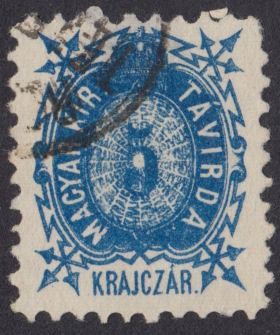 |
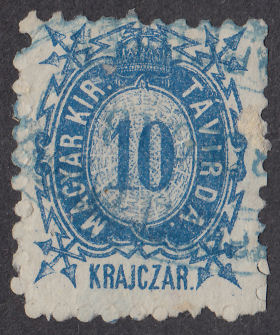 |
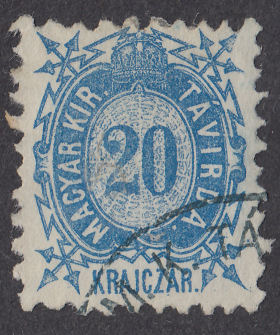 |
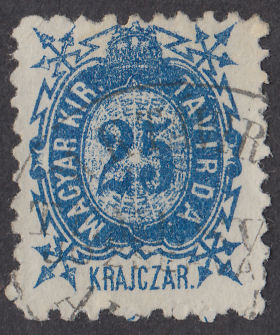 |
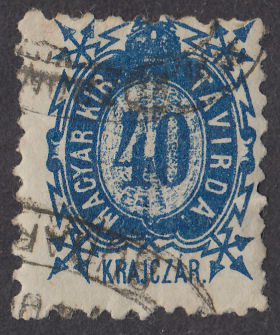 |
 |
| Type 1 5kr - H1a ? |
Type 1 10kr - H2 |
Type 1 20kr - H3 ? |
Type 1 25kr - H4 |
Type 1 40kr - H5a ? |
Type 1 50kr - H6a ? |
Krajczar = Kreuzer.
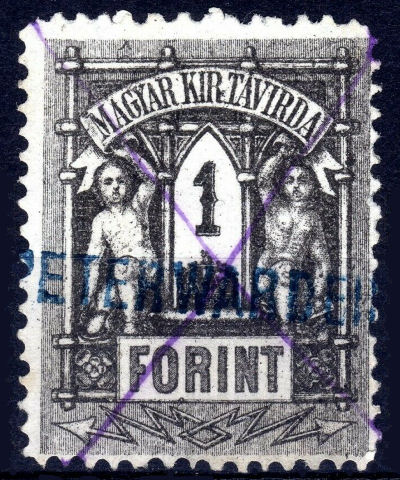 |
 |
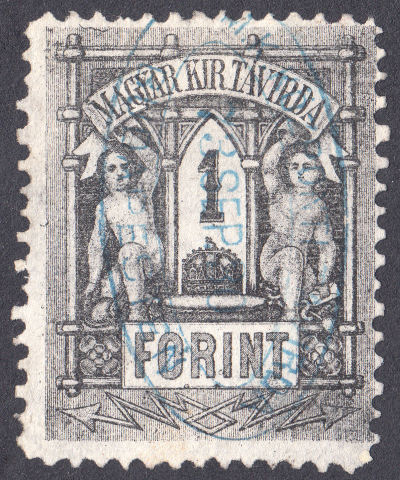 |
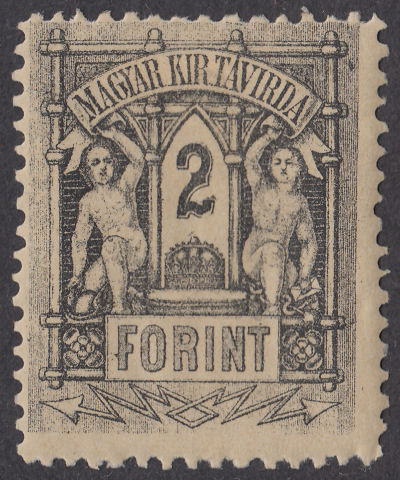 |
Type 2 1F - H7 - used
Courtesy of Patrick Conelly. |
Type 2 1F - H7 - used
Courtesy of Patrick Conelly. |
Type 2 1F - H7a - used 30 September 1873 at
M. K. Központi (Central) Tavirda, Budapest. |
Type 2 2F - H8 |
The first one was eBay item 293080539727 from 10 May 2019. If it is yours, please get in touch. I show it largely for comparison with the next image.
In addition though it has a cancel of "PETERWARDEN". The one with the blue oval cancel is a bit hard to see, but looks a bit like this :
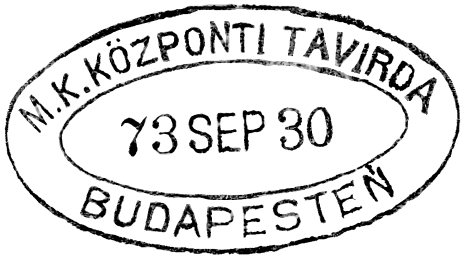
Multiples seem to be quite scarce. Here are a couple of pairs:
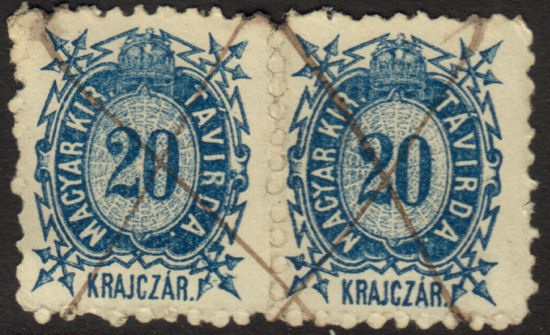
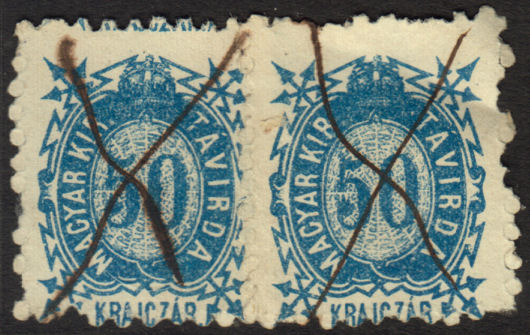
A pair of 20kr, H3a and a pair of 50kr, H6 courtesy of Patrick Conelly.
Steve Hiscocks makes much use of the colour "indigo" in his descriptions of these. However this colour name means
different things to different people, probably depending on what part of the world they learned English in.
Steve Hiscocks, being British was probably influenced by Newton who put it between blue and violet in the spectrum,
and the colour of indigo dye. These pre-dated pantone or web colours! In terms of these stamps I would say take it as a very dark blue
| Hisc. |
Description |
Mint |
Used |
| H1 |
5kr darkish blue |
32.50 |
13.00 |
| H1a |
indigo |
45.50 |
18.00 |
| H2 |
10kr darkish blue |
57.00 |
25.00 |
| H2a |
indigo |
80.00 |
35.00 |
| H3 |
20kr darkish blue |
39.00 |
13.00 |
| H3a |
indigo |
54.00 |
18.00 |
| H4 |
25kr darkish blue |
84.00 |
37.00 |
| H4a |
indigo |
110.00 |
52.00 |
| H5 |
40kr darkish blue |
21.00 |
27.00 |
| H5a |
indigo |
29.00 |
38.00 |
| H6 |
50kr darkish blue |
41.00 |
17.00 |
| H6a |
indigo |
57.00 |
24.00 |
| H7 |
1F black |
265.00 |
100.00 |
| H7a |
grey-black |
265.00 |
100.00 |
| H8 |
2F black / brownish yellow |
12.00 |
12.00 |
| H8a |
imperf. between horizontal pair |
120.00 |
- |
Hiscocks added the following 2 notes:
Note 1. Morley lists a variety of No. 8 (i.e. lithographed) perforated 13.
I find no other evidence of this but am open to correction. |
| Note 2. No. 8 is on surface coloured paper to help avoid confusion with No. 7. |
1874 Similar to above but engraved on thin hard paper. Perf. 13.
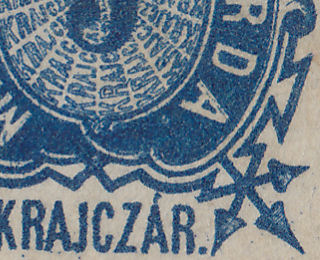 |
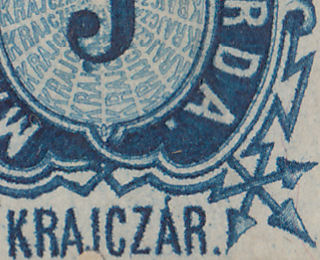 |
| 5kr Perf. 9½ Lithographed. |
5kr Perf. 13 Engraved. |
Krajczàr is Hungarian for Kreuzer, the currency.
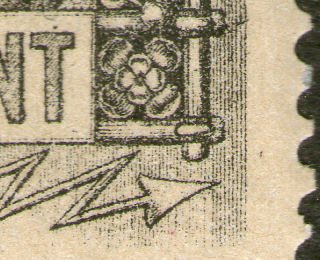 |
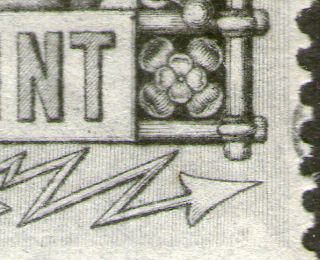 |
| 2F Perf. 9½ Lithographed. |
1F Perf. 13 Engraved. |
 |
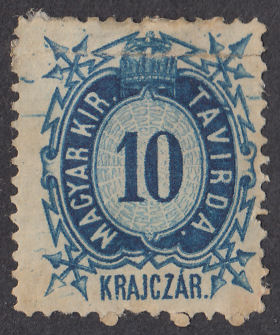 |
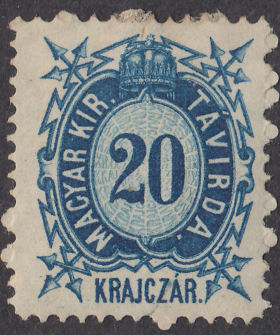 |
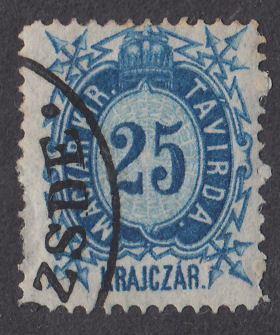 |
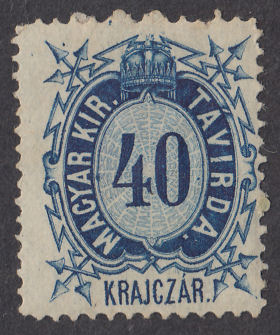 |
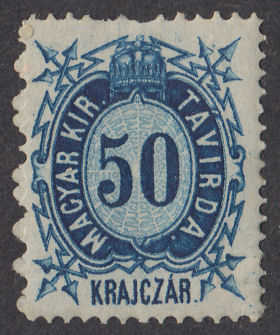 |
| Type 1 5kr - H9 |
Type 1 10kr - H10 |
Type 1 20kr - H11 |
Type 1 25kr - H12a ? |
Type 1 40kr - H13 |
Type 1 50kr - H14 |
 |
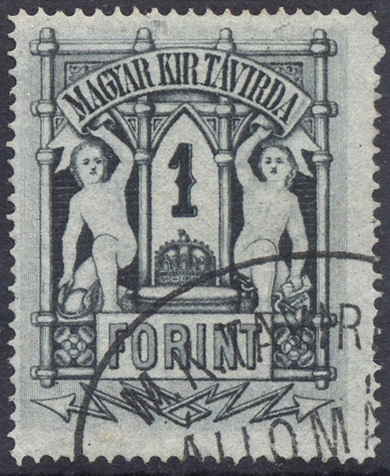 |
 |
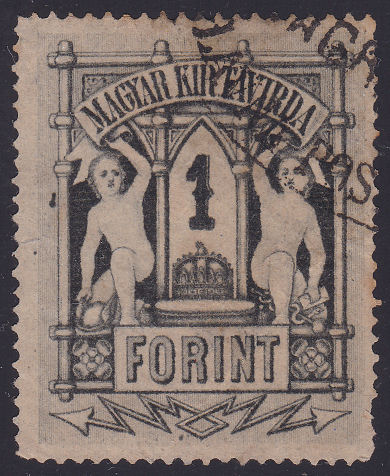 |
| Type 2 1F - H15 or H15a |
Type 2 1F - H15 or H15a - courtesy of Rolf Lamprecht |
Type 2 1F - H15 or H15a - two more paper colours. Black ink measures about the same though. |
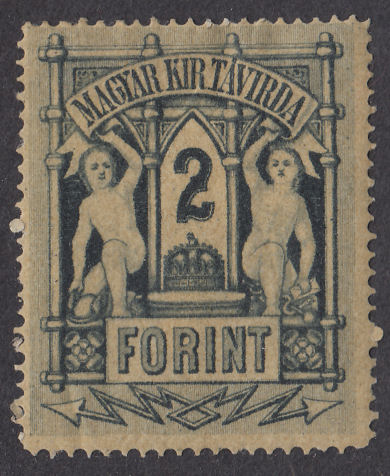 |
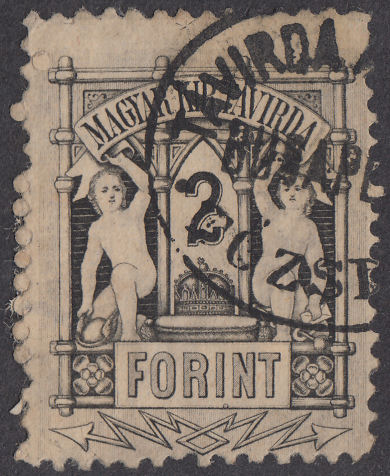 |
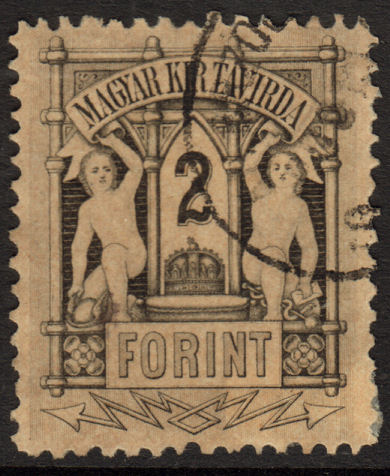 |
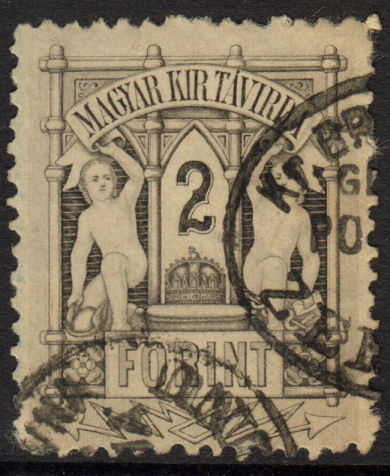 |
| Type 2 2F - H16a |
Type 2 2F - H16b |
Type 2 2F - H16b - courtesy of Patrick Conelly |
Type 2 2F - H16c - courtesy of Patrick Conelly |
To me, it seems like the colour of the paper is more important than the shades of grey/black printing ink.
Stationery
From 1868 to 1918 there existed an independent Kingdom of Croatia-Slavonia as an autonomous region within the Austro-Hungarian Empire.
The Capital was Zagreb and principal language was Croatian. Though not affecting the Telegraph stamps, it did affect stationery.
Sending Forms
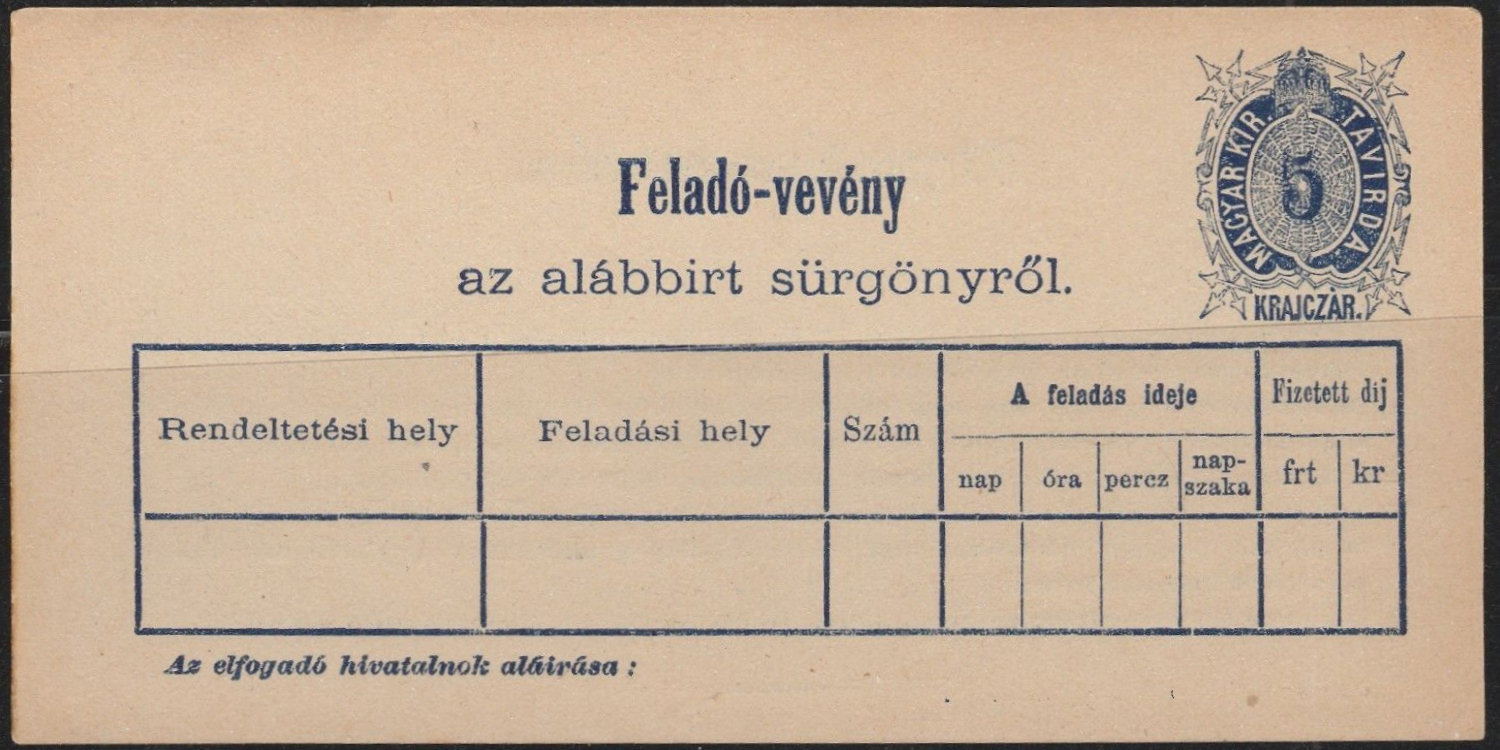
This appears to be a receipt for a telgram that would have been below. Image courtesy of TreasuringsJewelry (click image for eBay listing).
| Feladó-vevény = Consignor-buyer |
az alábbirt sürgönyről = the Telegram below |
Rendeltetési hely = Destination |
Feladási hely = Place of dispatch |
| Szám = Number |
A feladás ideje = Time of dispatch |
Fizetett dij = Paid fee |
Az elfogadó hivatalnok aláirása = Signature of the accepting officer |
This is bi-lingual version, with Hungarian (left/top) and Croatian, of the form above.
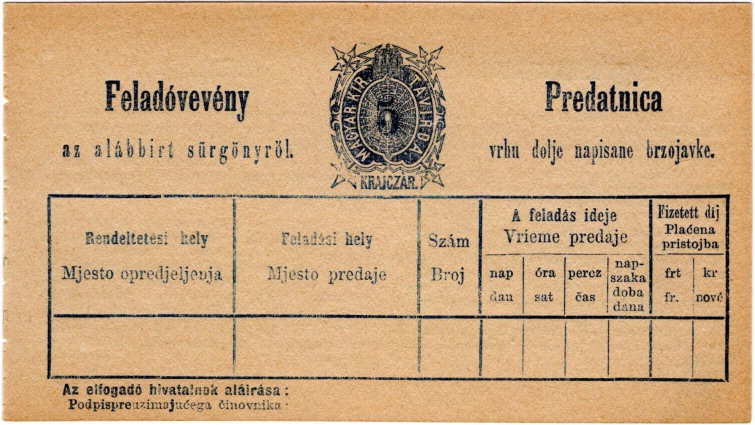
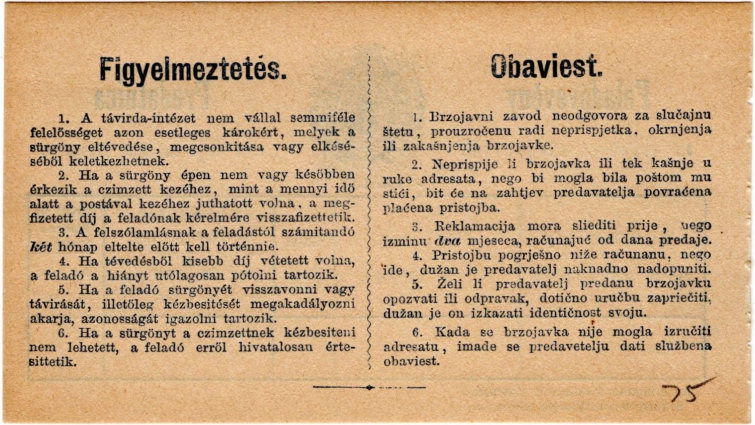
Image courtesy of TreasuringsJewelry (click image for eBay listing).
Telegram sending card.
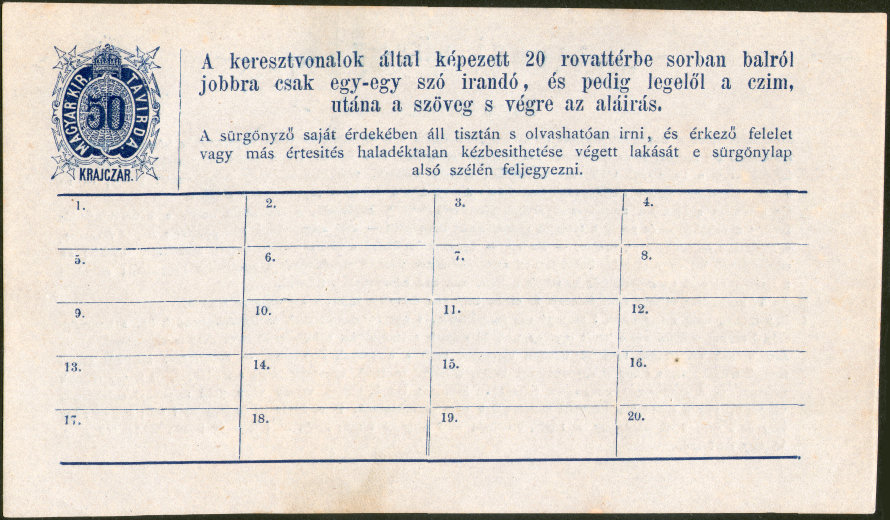
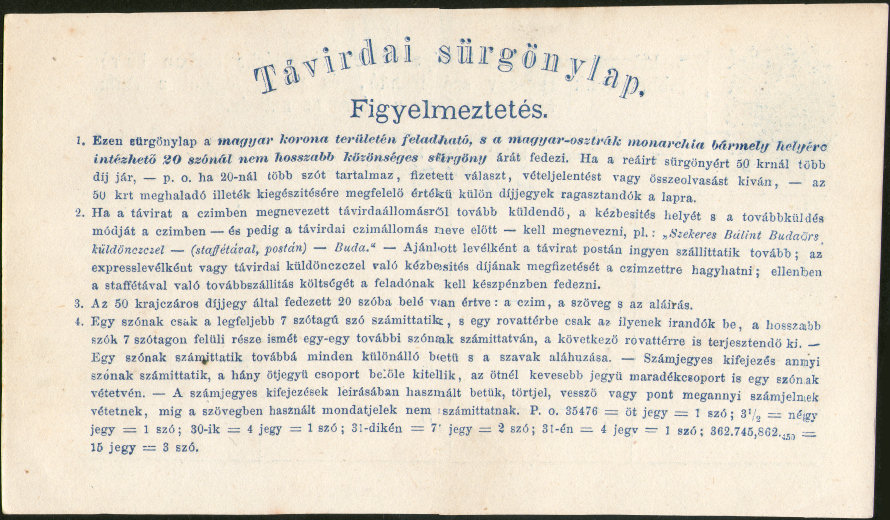
A keresztvonalok által képezett 20 rovatté rbe sorban balról
jobbra csak egy-egy szó irandó, és pedig legelől a czim, utána a szöveg s végre az aláirás.
A sürgönyző saját érdekében áll tisztán s olvashatóan irni, és érkező felelet vagy más értesités haladéktalan kézbesithetése végett lakását e sürgönyzlap alsó szélén feljegyezni. |
= |
In the row 20 boxes formed by the crosslines from the left
only one word is written to the right, and the address is written first, then the text and finally the signature.
It is in your own interest to write clearly and legibly and to record your apartment on the lower edge of this telegram for the immediate delivery of an answer or other information. |
Távirat-lap (Telegram-sheet) - outside. Figyelmeztetés = Warning.
#2 says : "E lap ára 31 kr. melylyel belföldre vagy Ausztriába és Németországba szóló táviratnál
10 szó díja is meg van fizetve; a 10 szón felüli díjak (egy szó 3 kr.) a belső lapon megjelőlt helyen
megfeleló értékü levéljegyek felragasztásával rovandók le. Ha a távirat oly helységbe van címezve, hol
csak vasuti távirda van, kézbesitési díjul még 15 kr. franko-jegyet kell ezen lap kijelőlt helyére ragasztani."
meaning : "The price of this card is 31 kr. with which the fee of 10 words is paid when sending a telegram to Hungary or Austria and Germany;
the fees of more than 10 words (one word is 3 kr.) by affixing the corresponding letter marks in the place indicated on the inner sheet.
If the Telegram is addressed to a place where there is only a railway Telegram, the delivery fee is 15 kr. a franko ticket must be affixed to the outside of this sheet.".
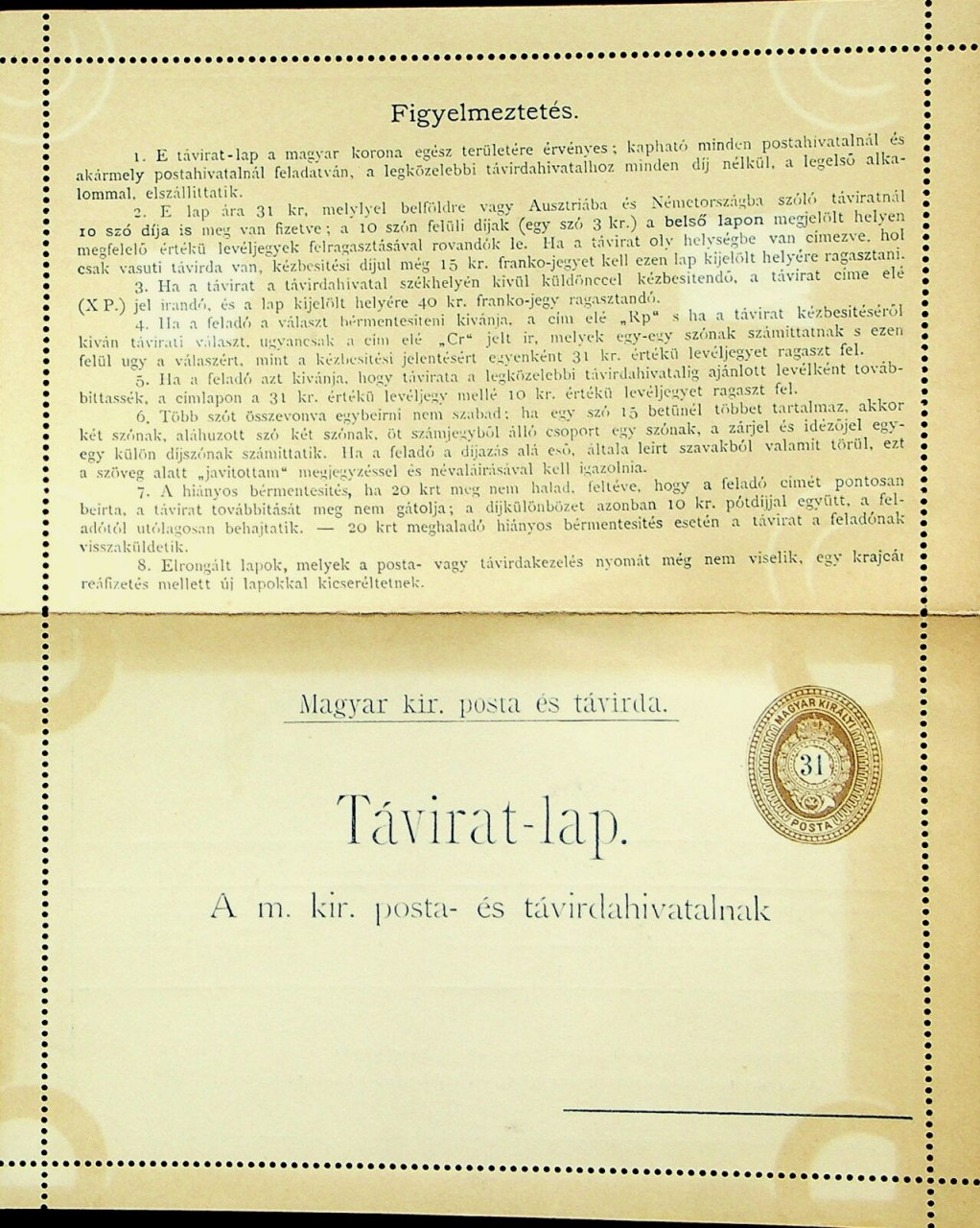
The outside-front caries a 31kr impressed stamp.

Images courtesy of TreasuringsJewelry (click image for eBay listing).
A used bi-lingual version (outside only), dated 22 April 1894.
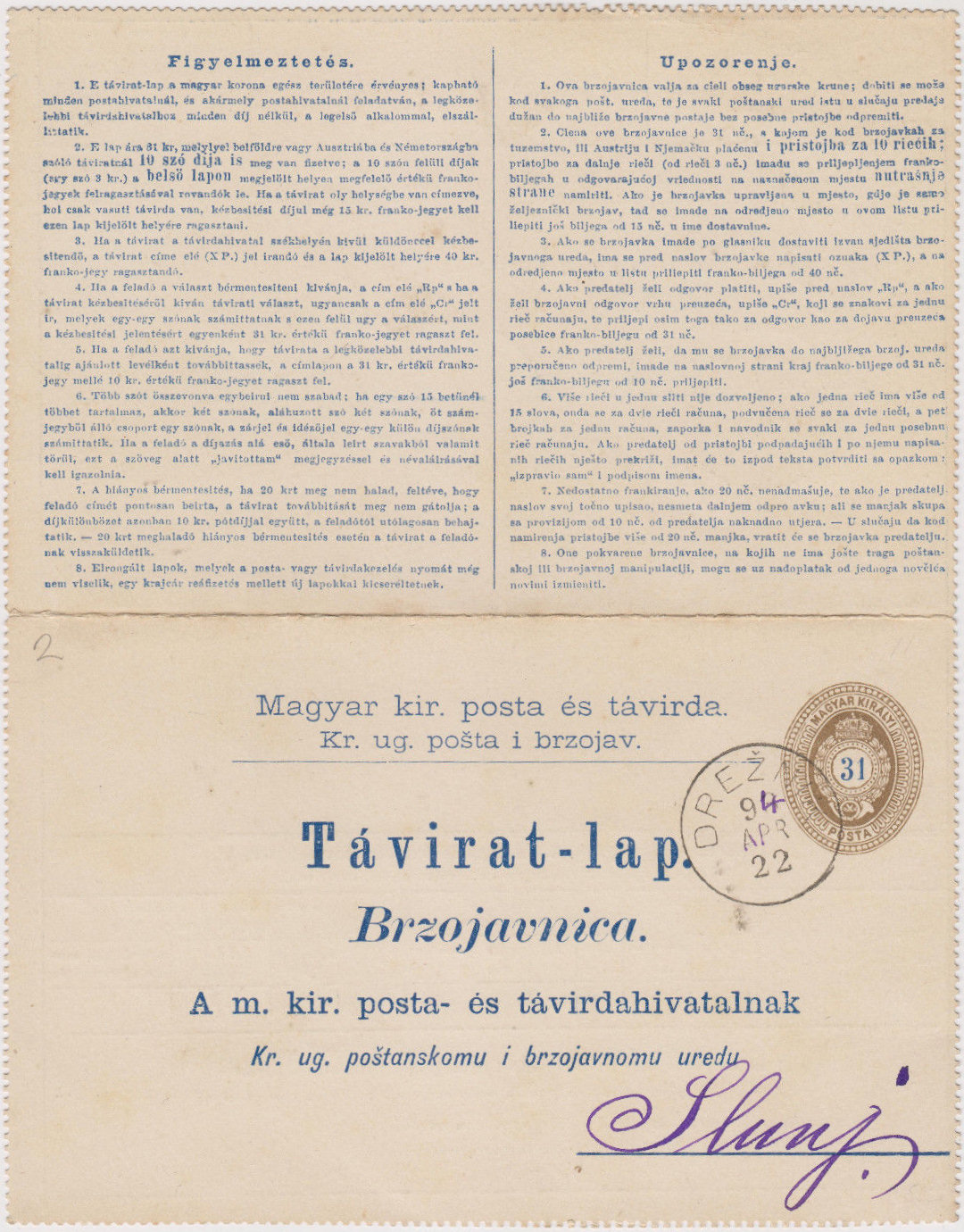
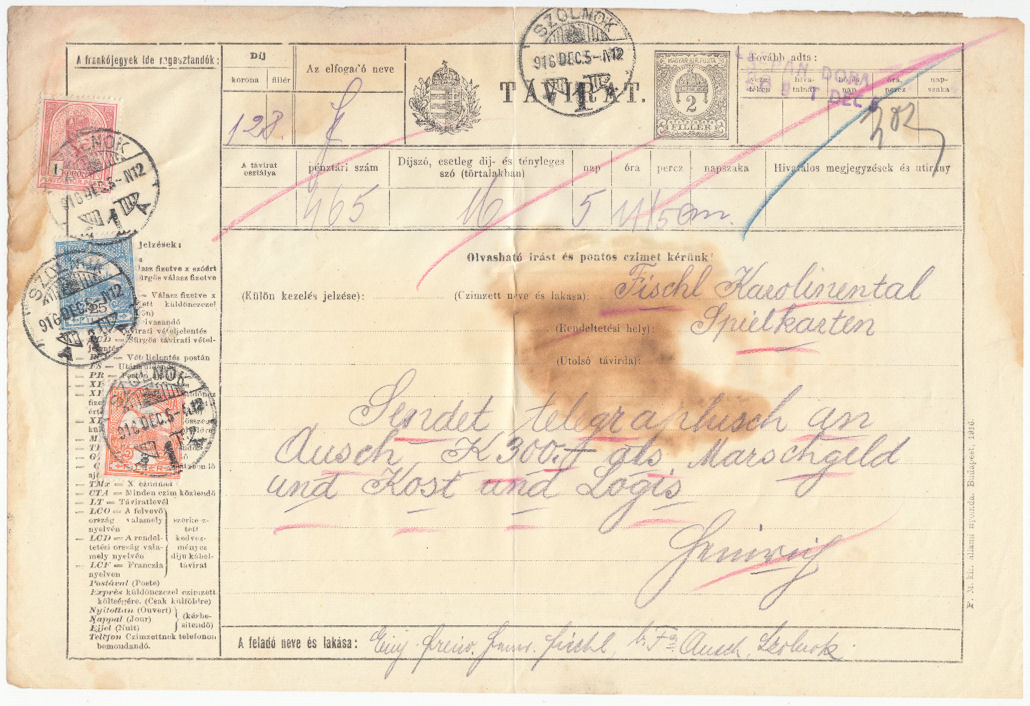

A third size Telegram of December 1916 to Szolnok written in German. 2 filler pre-stamped plus 1K28. It was printed in Budapest.
Another example, this used 1919 in Fiume for a message to Trieste. Now with 10 filler pre-stamped.
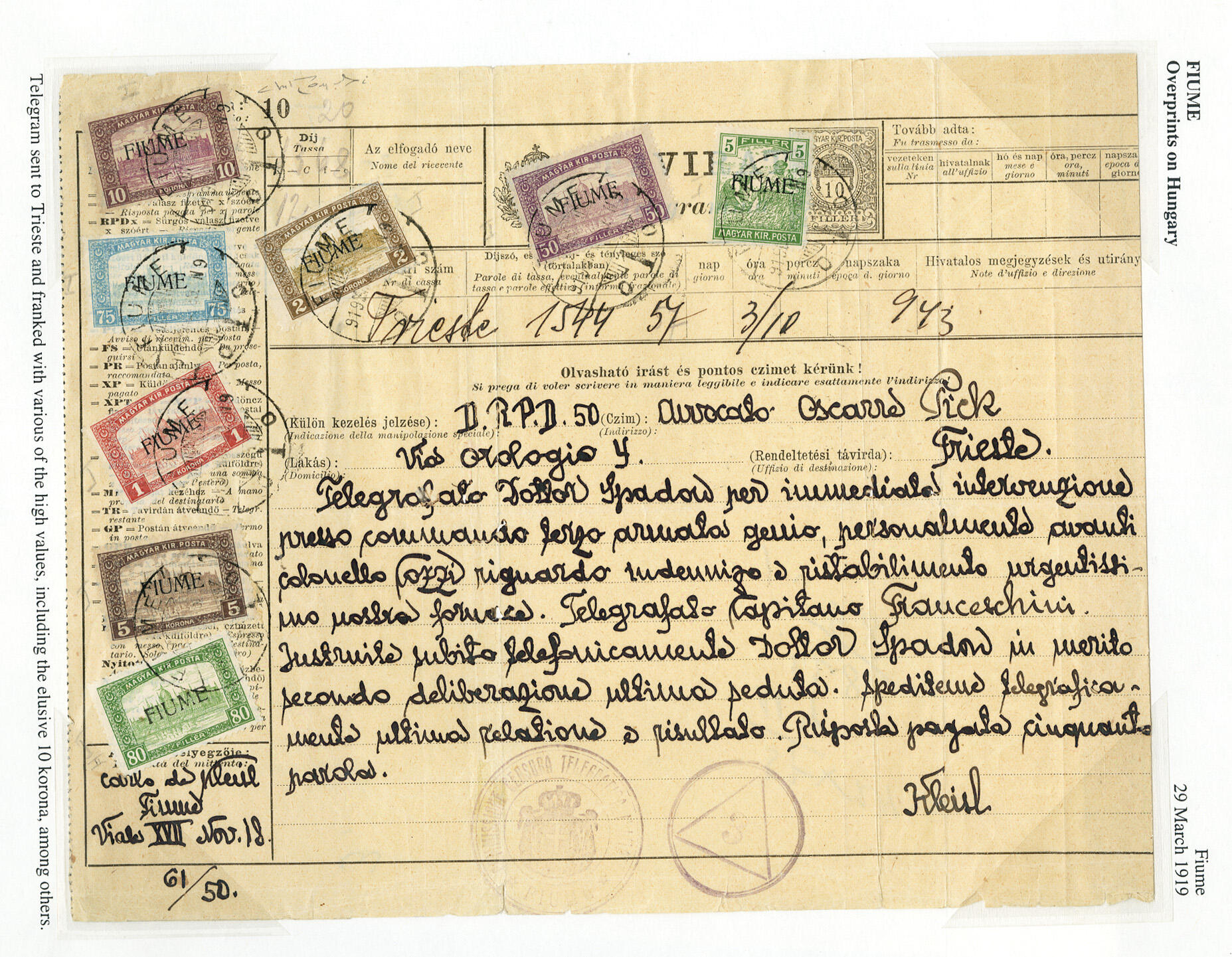
Imprint not visible/removed and rather philatelic, totalling 20K20f, though the indicated "dij" at top-left is different. But some interesting cancels. Image courtesy of Cherrystone Auctions.
Delivery Forms
Form 65. a)
Used at Pancsova on 8 November 1875 (Állomás = Station).
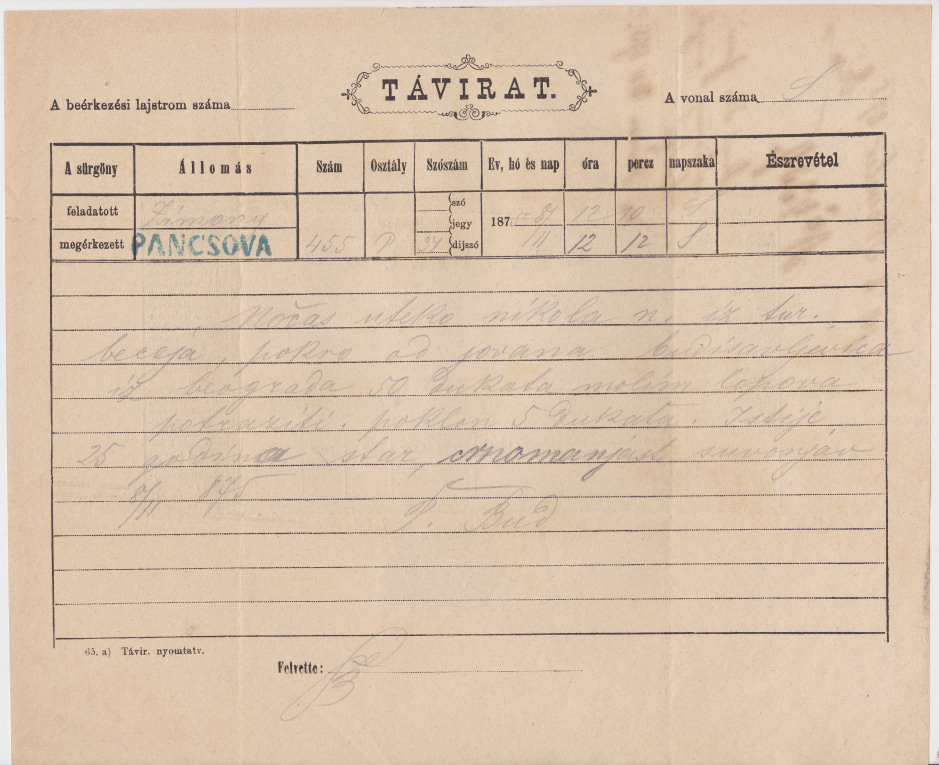
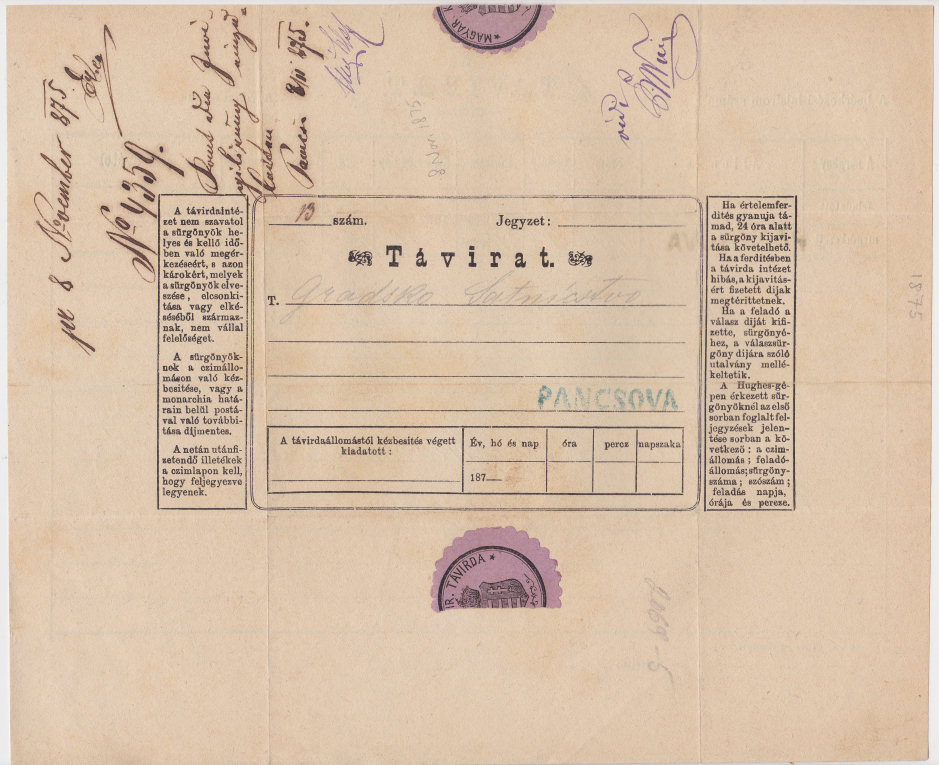

The bottom imprint of "65. a) Távir nyomtatv." presumably shows the Form number. Távir nyomtatv = Telegram printed.
Used at Pancsova on 3 July 1877. Headings on both side have changed style.
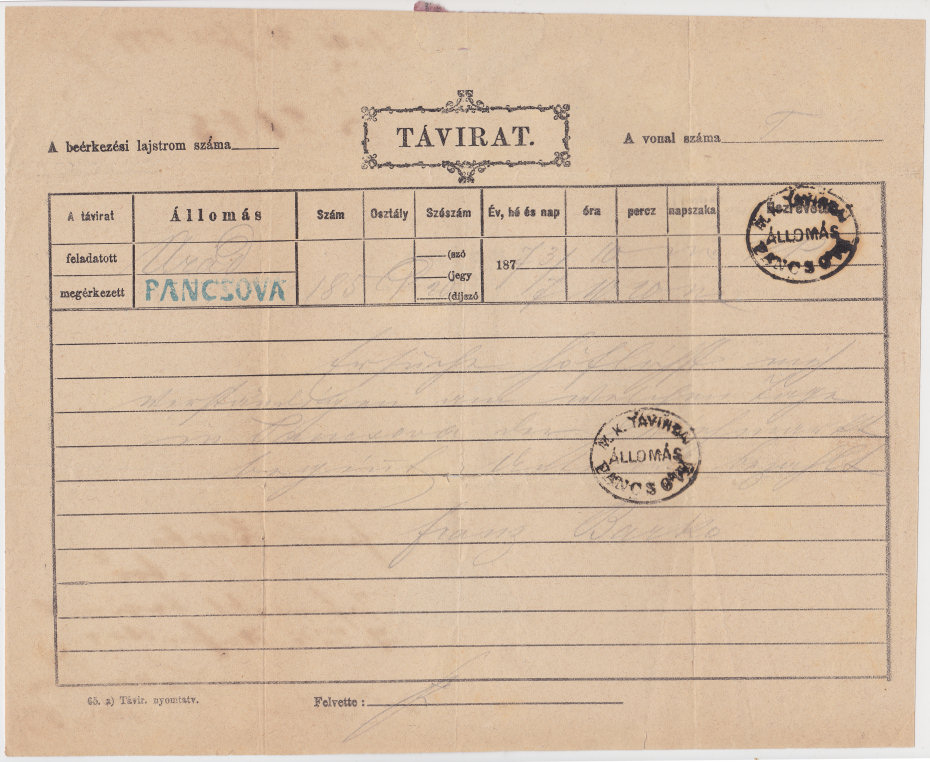
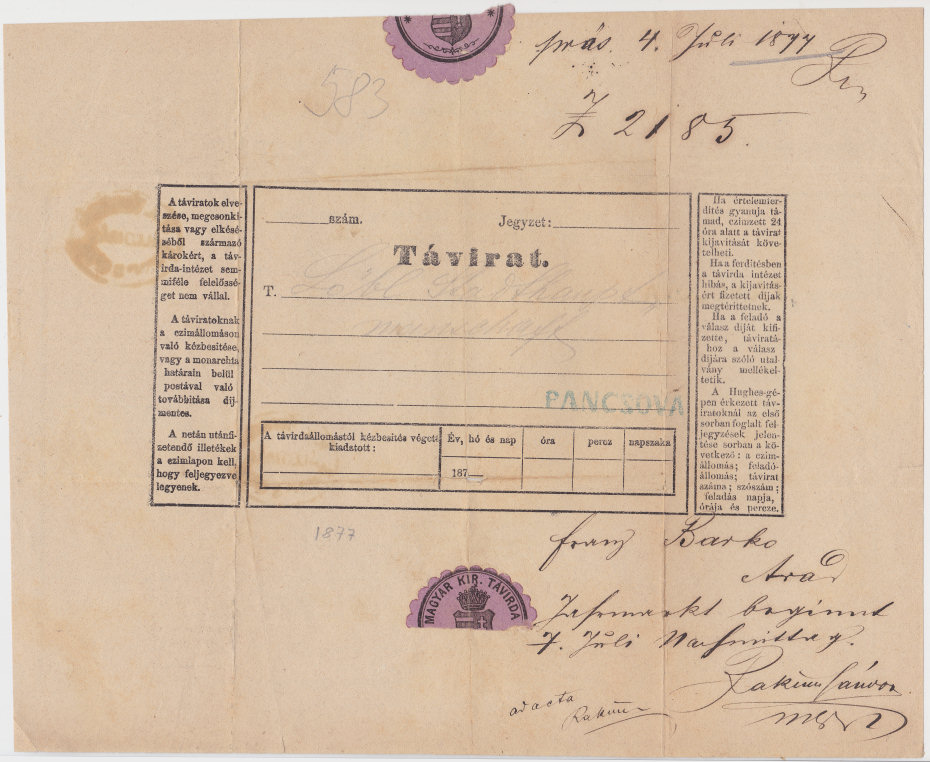

The bottom imprint of "65. a) Távir nyomtatv." is the same as the last.
A Bi-lingual form, used at Osijek (now fourth largest city in Croatia) on 4 December 1878.
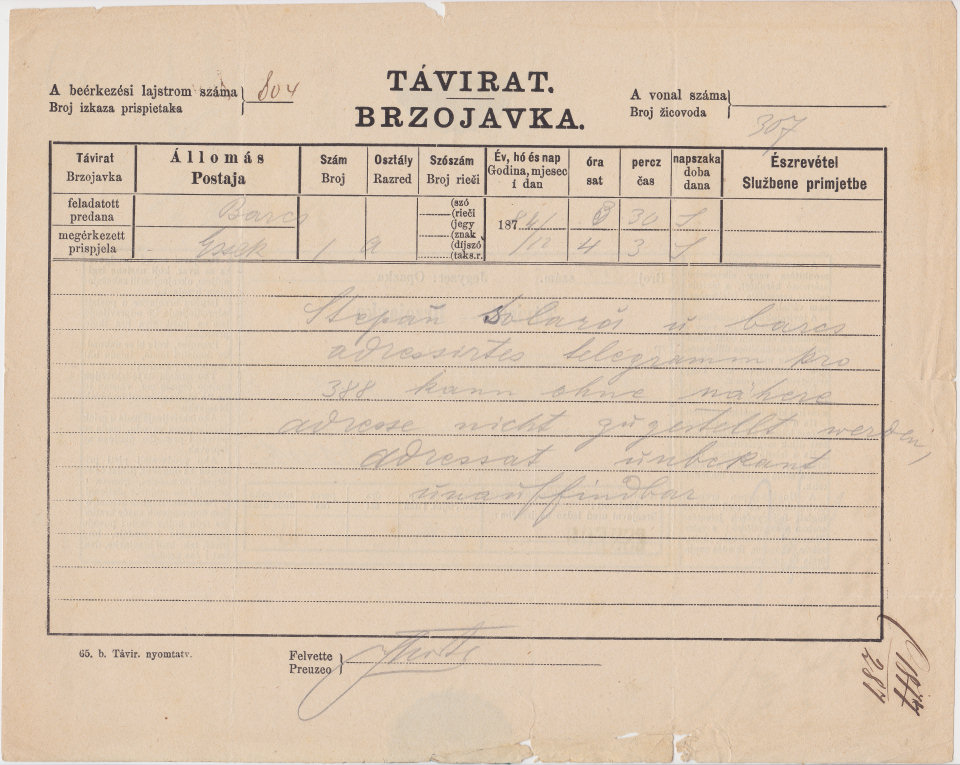
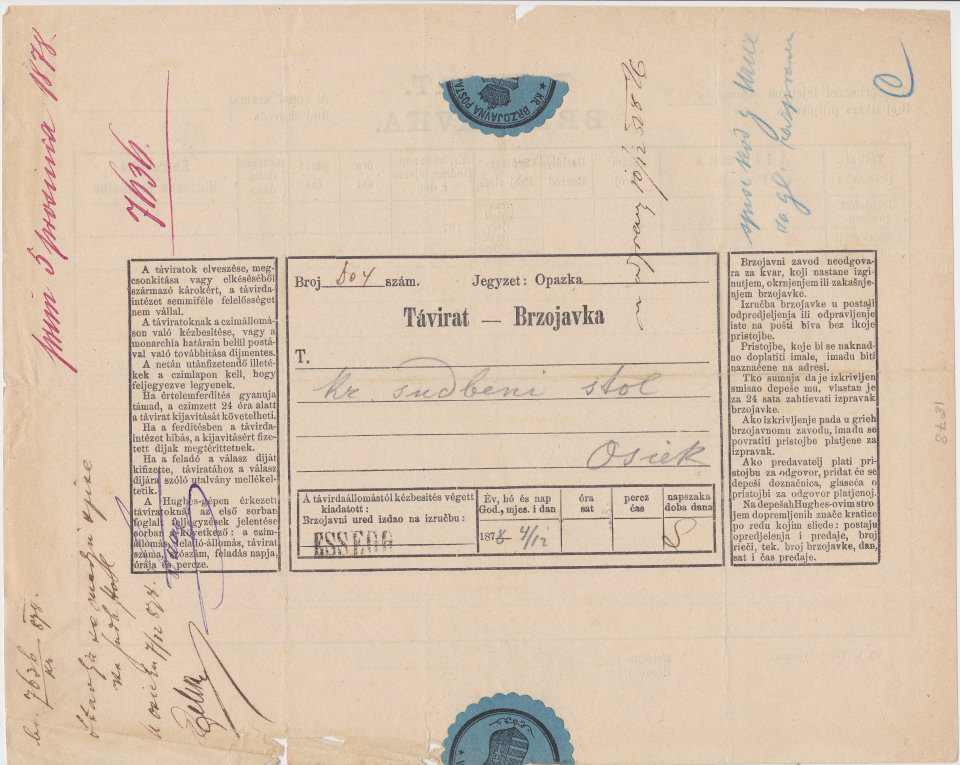

The bottom imprint is the same as the last.
Used at Pancsova on 27 August 1879.
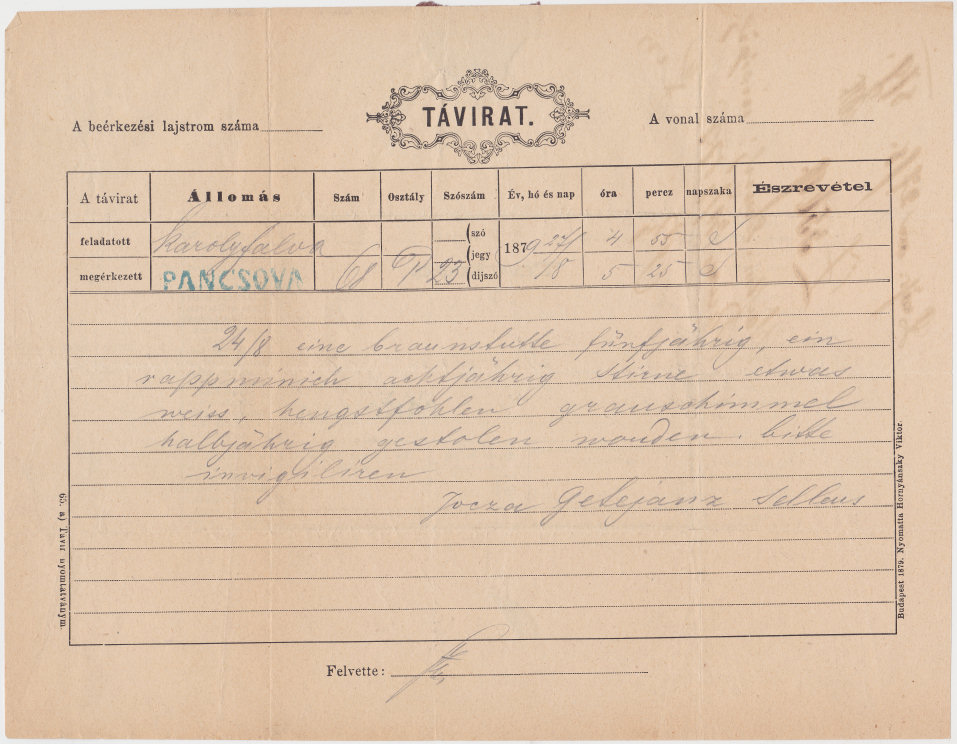
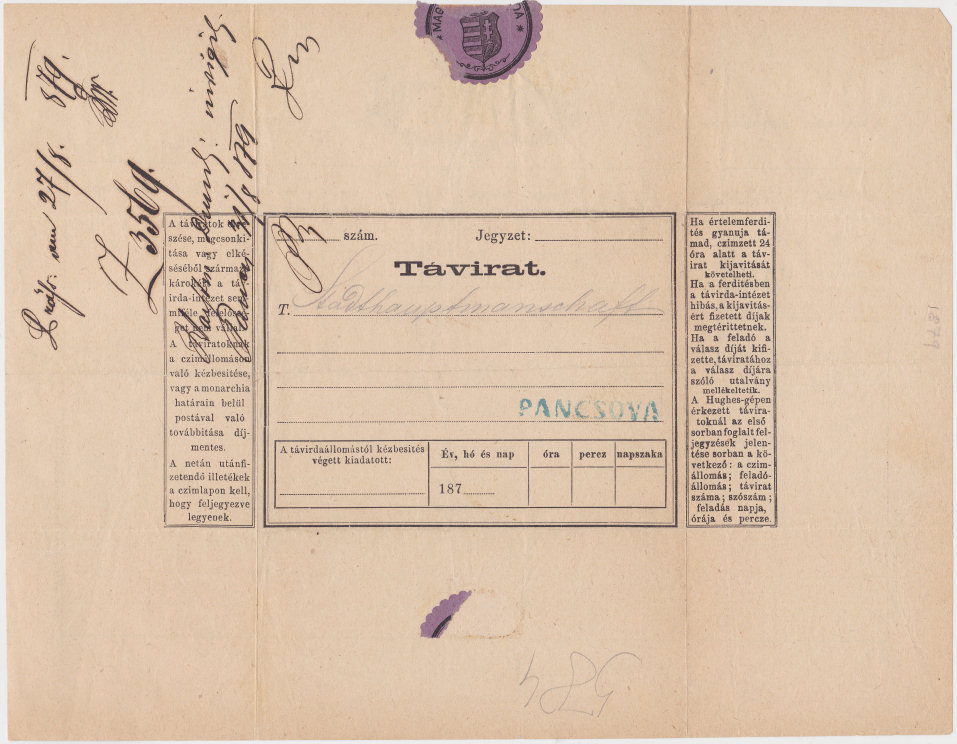


The left side imprint now has "Távir Nyomtatványm." meaning "Telegram Form". The right imprint indicates that it was prined 1879 in Budapest by Viktor Hornyanszky.
Another Bi-lingual form, used at Vinkovce (oldest town in Europe and in Croatia) on 19 February 1881.
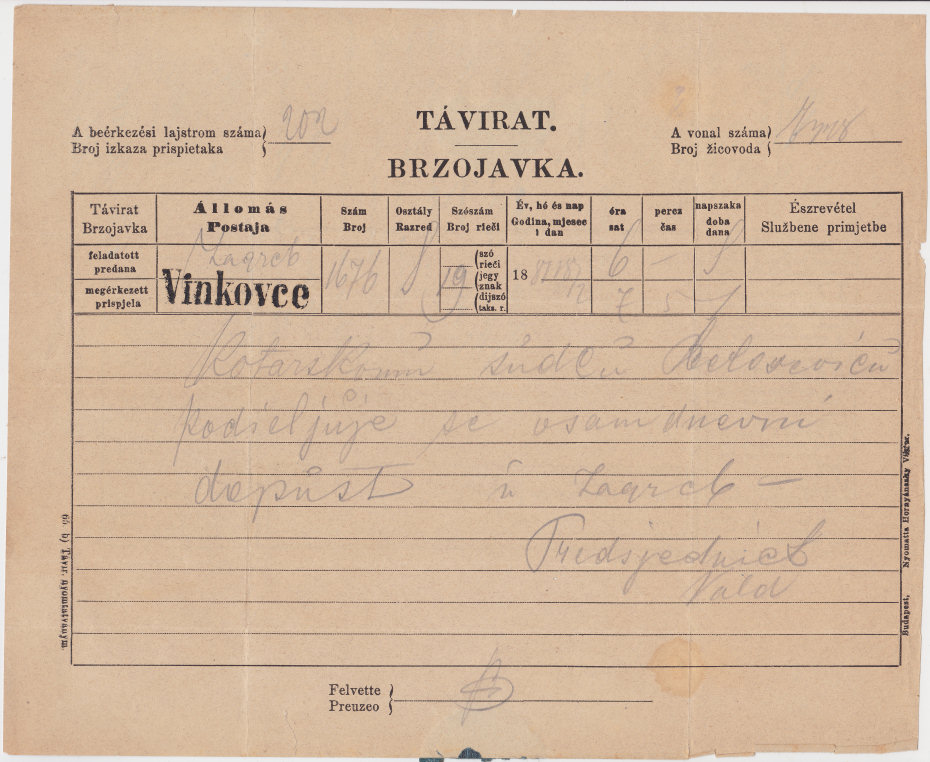
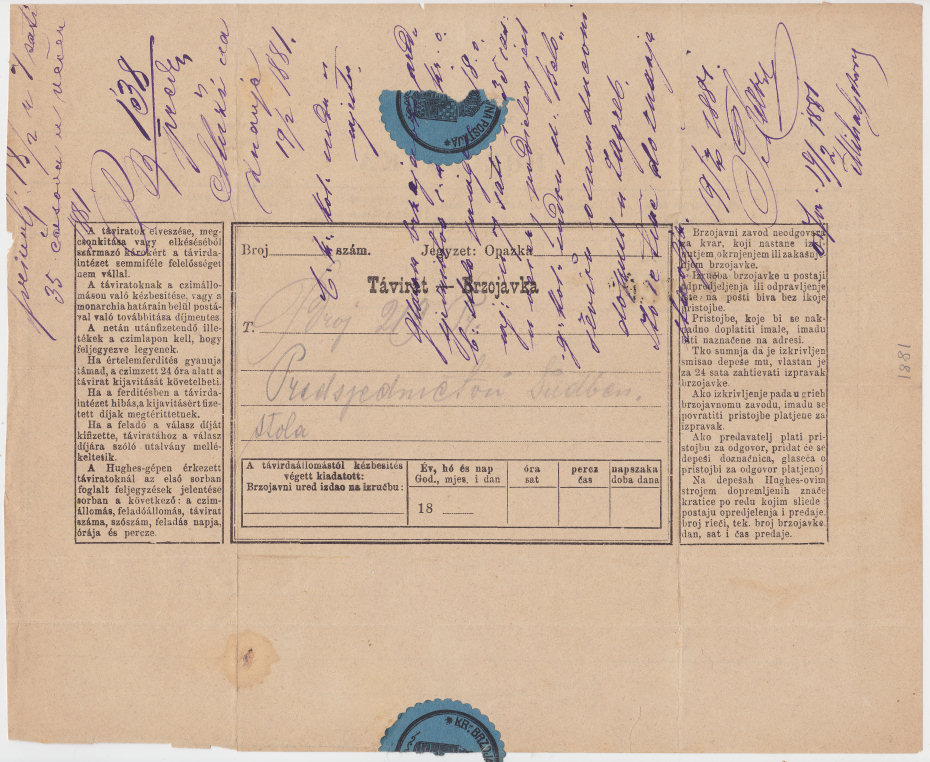


The left side imprint still has "Távir Nyomtatványm." meaning "Telegram Form". The right imprint still indicates that it was prined in Budapest by Viktor Hornyanszky, but the year has been deleted.
When strips were starting to be used, they used an international standard and new, smaller forms were introduced.
The strips had codes at the beginning of them that required explanation. Lists of these codes and their meaning needed to be added to the forms.
The early ones had few codes and could be squeezed into a box at top-right. This worked up to about 10 codes, then the list was moved to the bottom of the form.
That worked up to 20 codes, then it was moved to the back of the form.
Form "small" with Coat of Arms.
A series of small forms, with plain backs and no clear form number.
Still Form 65, but with differences. A Bi-lingual form, used at Ilok (now in Croatia), printed in 1882.
4 codes are listed.

The imprint up the right side gives the Form number, year of 1882 and what looks like a printer in Budapest.

Form 365, A Bi-lingual form, used at Zagreb (now in Croatia). Imprint of 1896.
5 codes are listed.
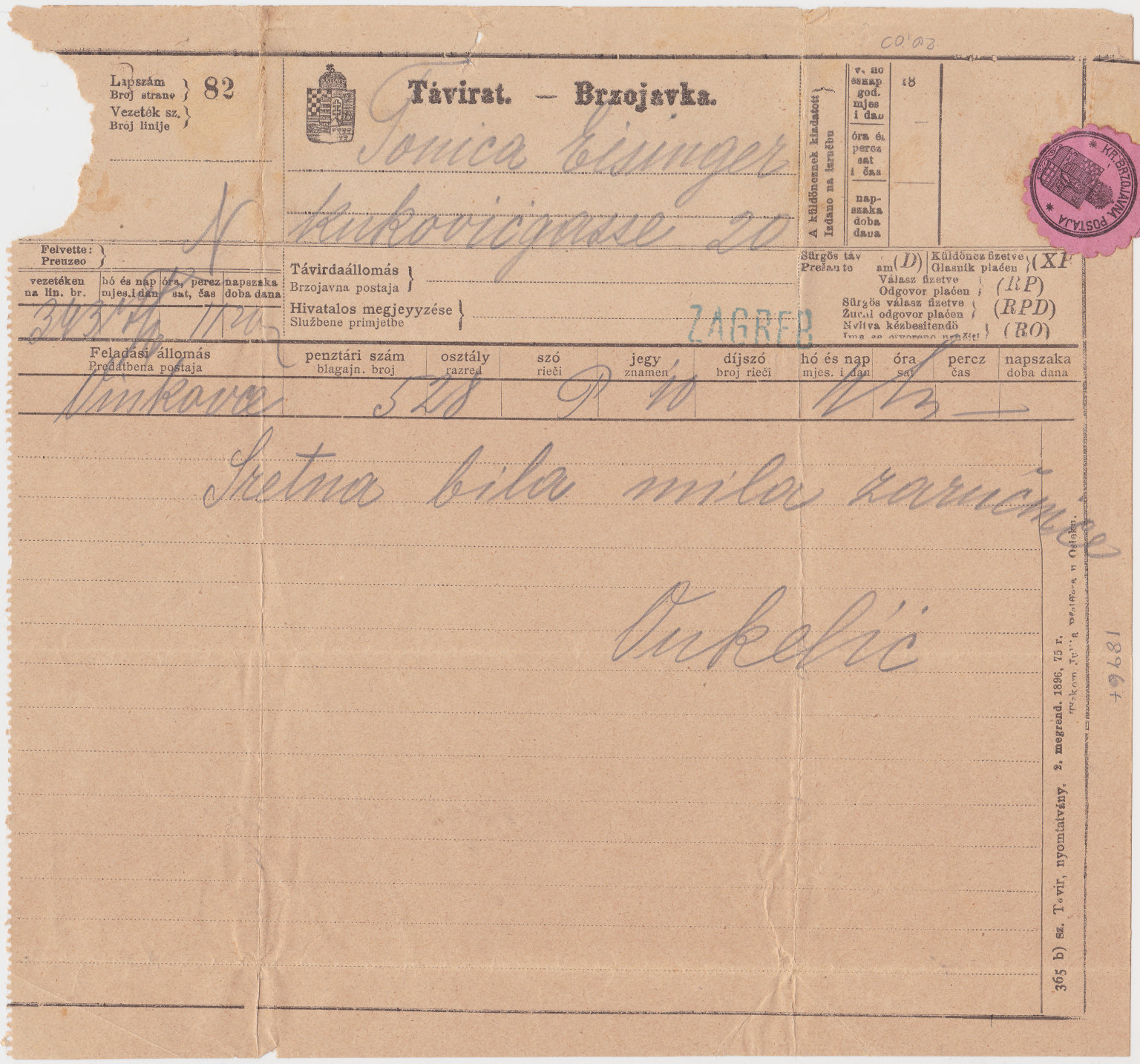

The imprint mentions 365 as possibly the form number, the year of 1896 and "Tiskom Julüa Pfeiffers u Osieku" (now in Poland).
Form 365, A poor image of a Hungary-only form, used at Nagy Szombat. The imprint looks like 1896, but this has more codes than the last.
Form (Nyomtatványszám) 365 now marked at the top. 6 codes are listed.
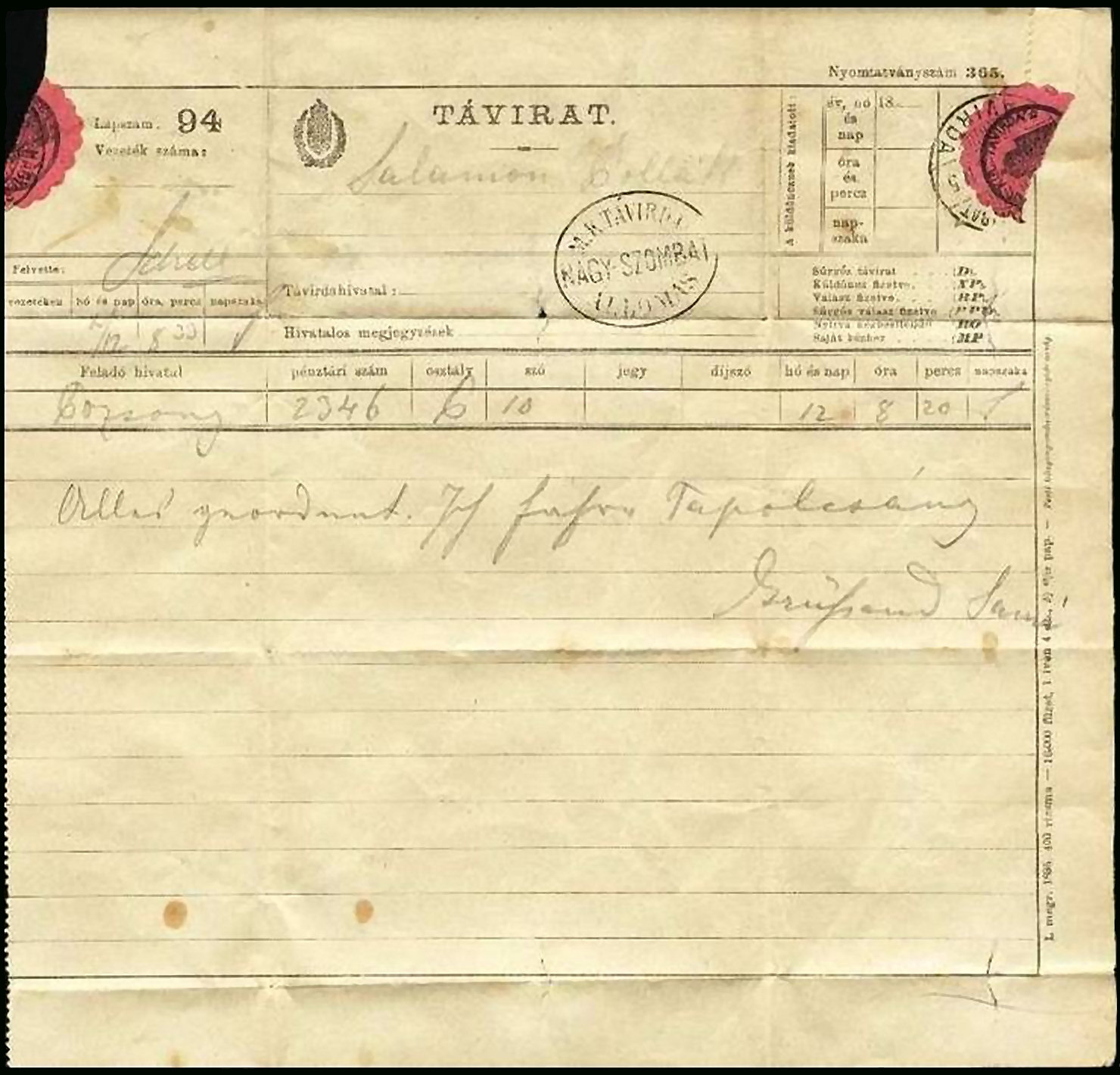

The imprint does not mention 365 and the year is unclear. It looks like Pesti könyvnyomda-részvény-társaság , the Pest book printing company.
Form 471, used in Déva, Transylvania (now in Romania). Undated.

Nyomtatványszám 471. Kézbesitendö távirat = Form number 471. Telegram to be delivered.
The form has a pre-prined year of "18...." and 10 codes are listed, so after 1896 but before 1900.
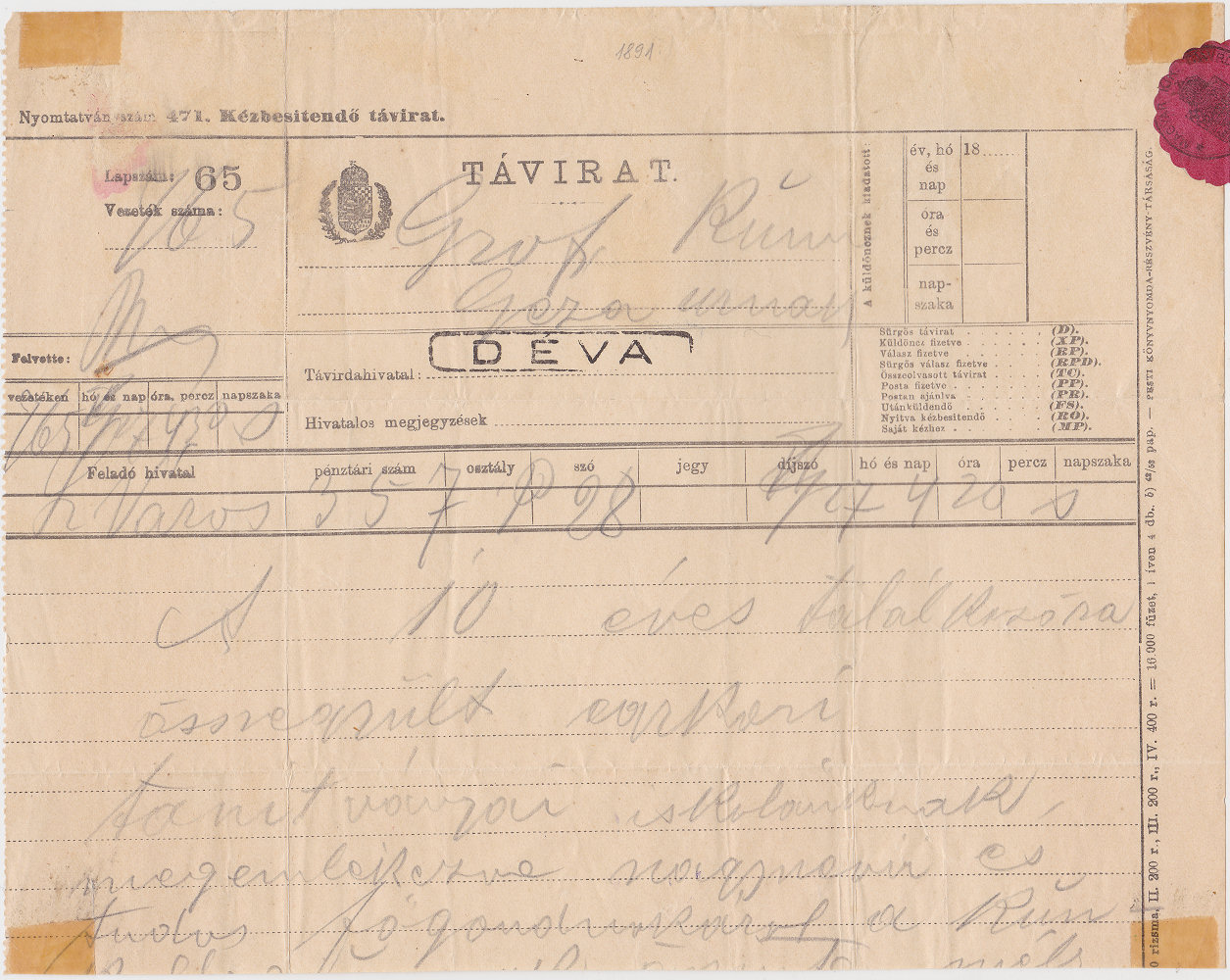
The imprint shows that some of the form is missing. There may have been a date. Pesti könyvnyomda-részvény-társaság indicates it was printed by the Pest book printing company.

Form Number ???
1902 Budapest using strips. This with code BP.
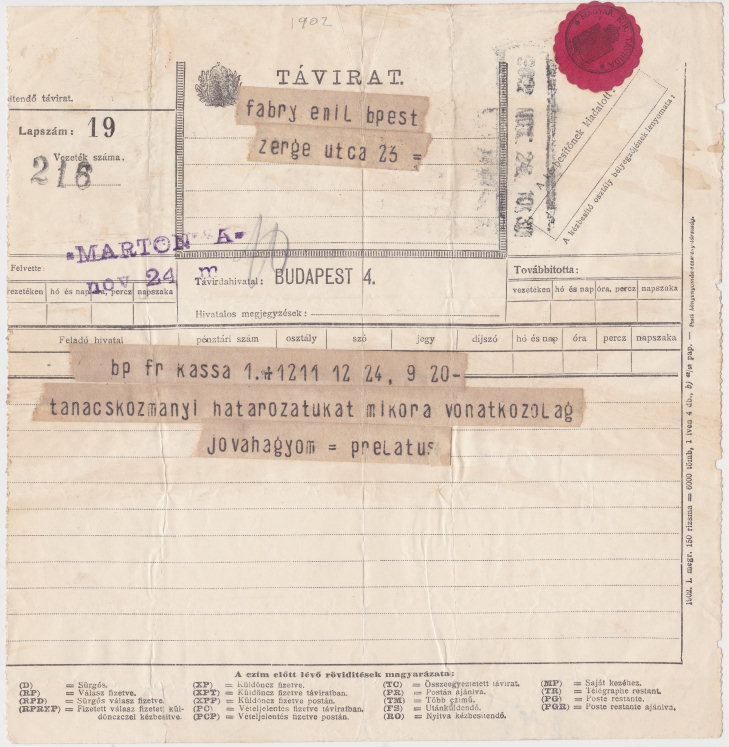
18 Codes at bottom.

"A czím elött lévö röviditések magyarázala" or "Explanation of abbreviations before Title"
 |
1903 the Kúria - no strips

18 Codes at bottom.

1903 "Pesti könyvnyomda-részvény-társaság." = "Pest book printing company (as 1902)." |
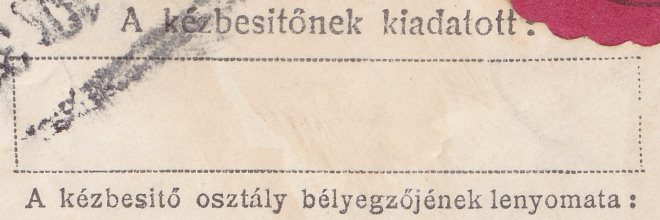
A slanted top-right box has —— A kézbesitönek kiadatott : = Extradited to the handler :
A kézbesitö osztály bélyegzöjének lenyomata : = Stamp of the delivery department :
It contains a vertical, unclear handstamp of "902 NOV 24. 10:30" |
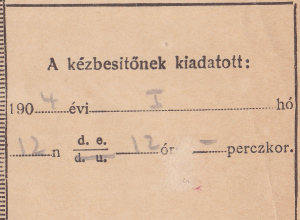
A kézbesitönek kiadatott : = Extradited to the handler :
It is filled in for January 1904 |
1910 - Zagreb (strangely) not using strips.
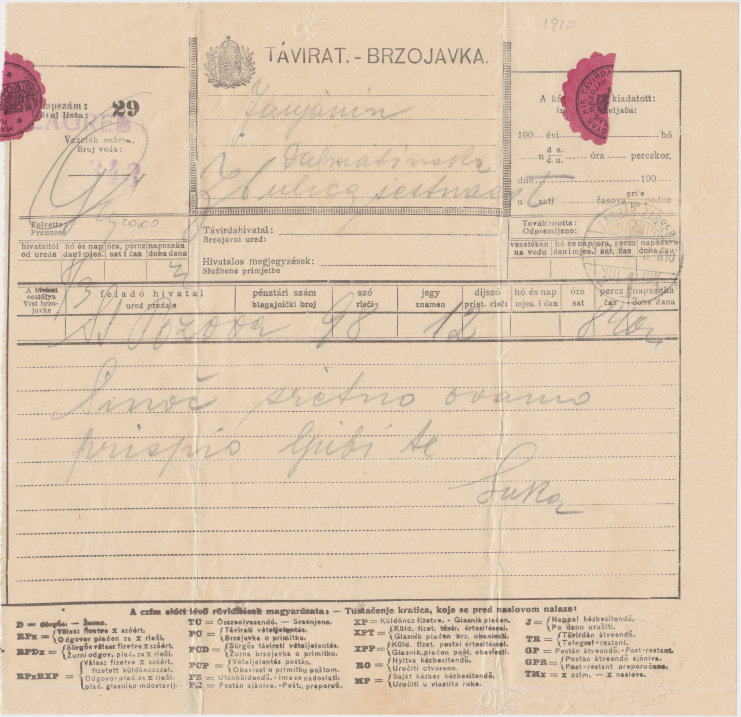
20 Codes. No imprint. |
1911 - Osijek using strips.

20 Codes. No imprint. |
A form dated 1912 in the imprint and used August 1913 in Detta (now in Banat, Romania).
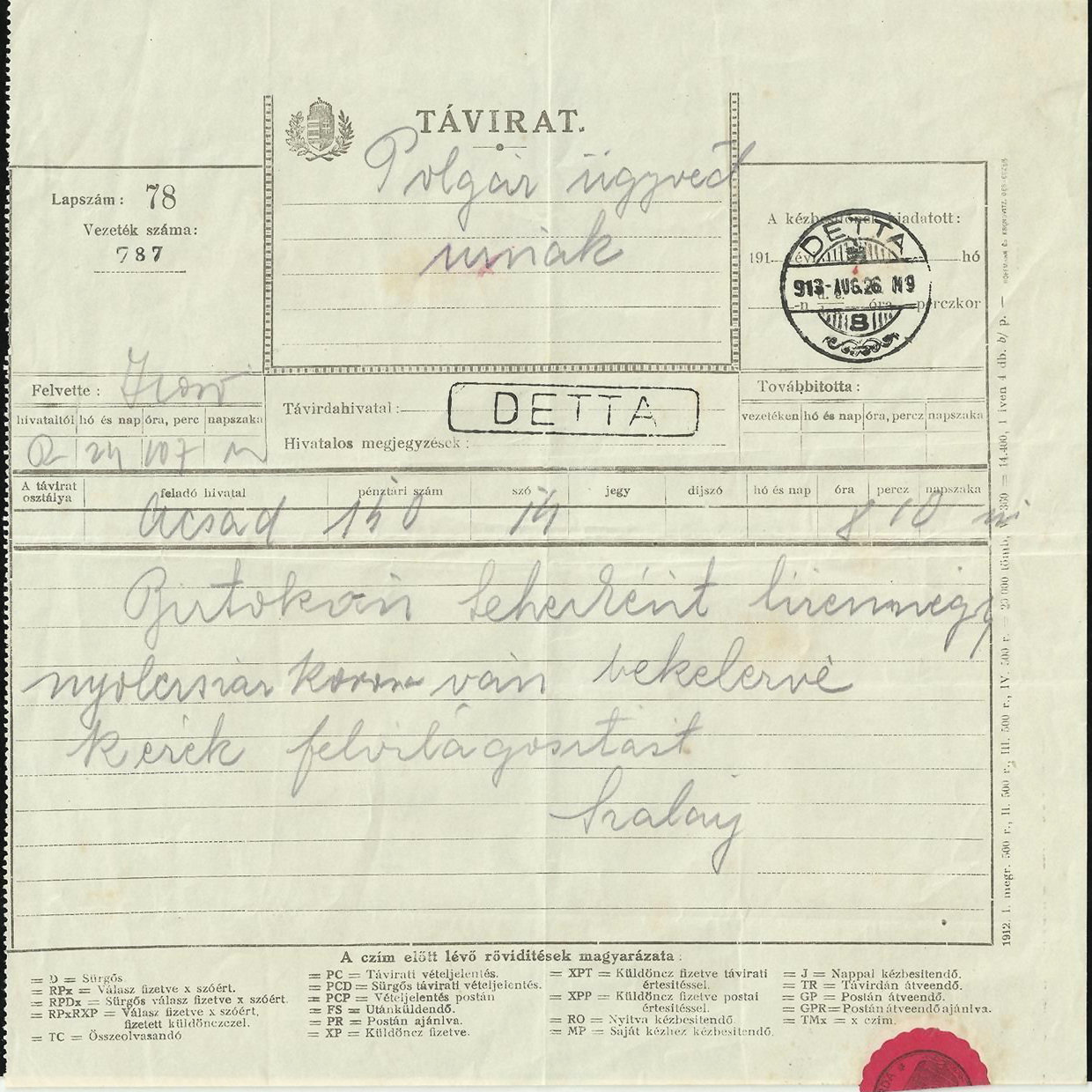
20 codes. The imprint has the date of 1912 and "Hoffmann és Kronovitz, Debreczen",

A form dated 1913 in the imprint
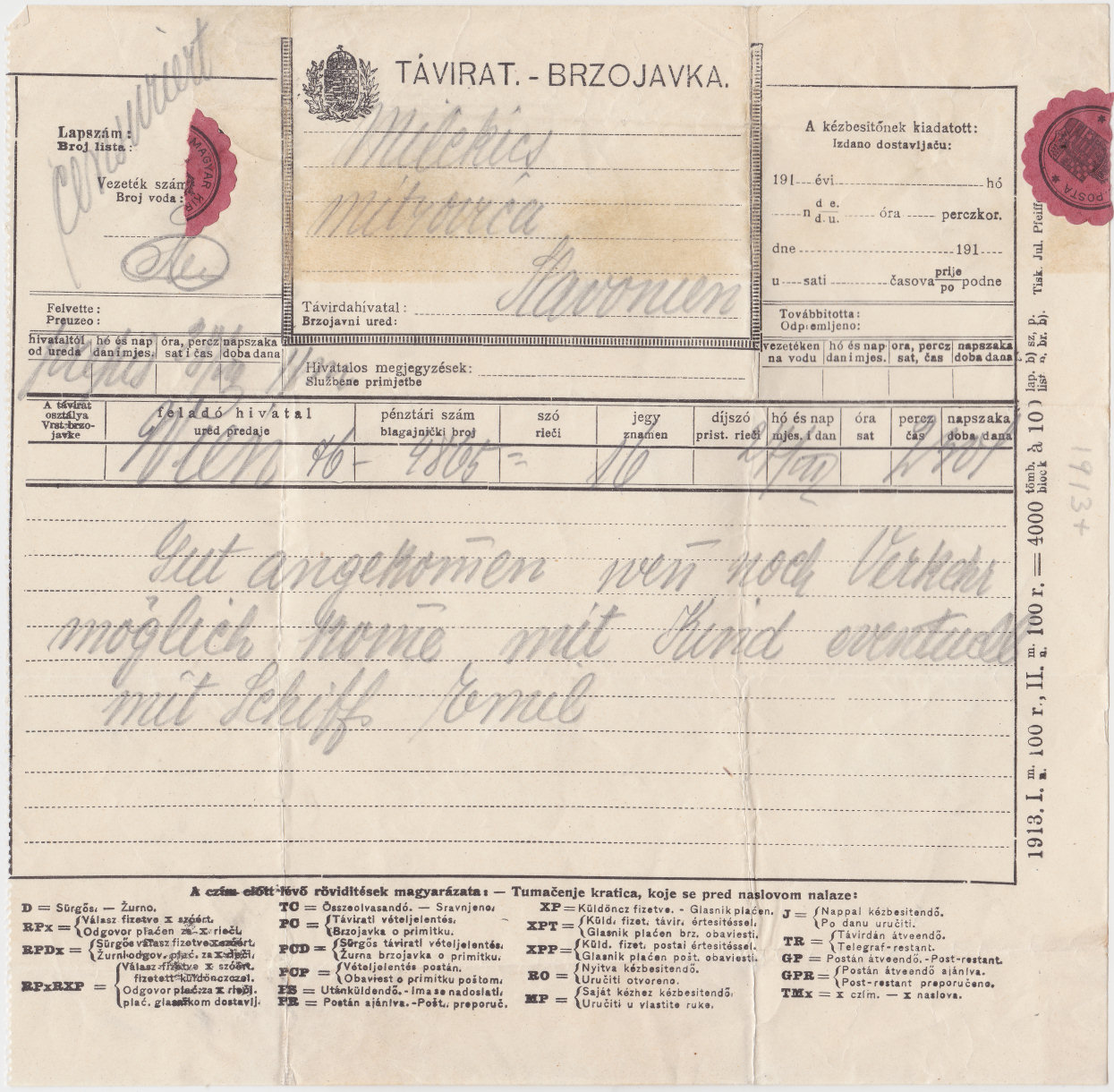
20 codes. The imprint has the date of 1913 and "Tiskom Jul. Pfeiffers, Osieku.", (see form of 1896).

Double-sided, 23 codes now on the back.
A form dated 1914 and marked "Kézbesitendö távirat" at the bottom (Telegram to be delivered).
On the back is "A czím elött lévö röviditések magyarázala" or "Explanation of abbreviations before Title".

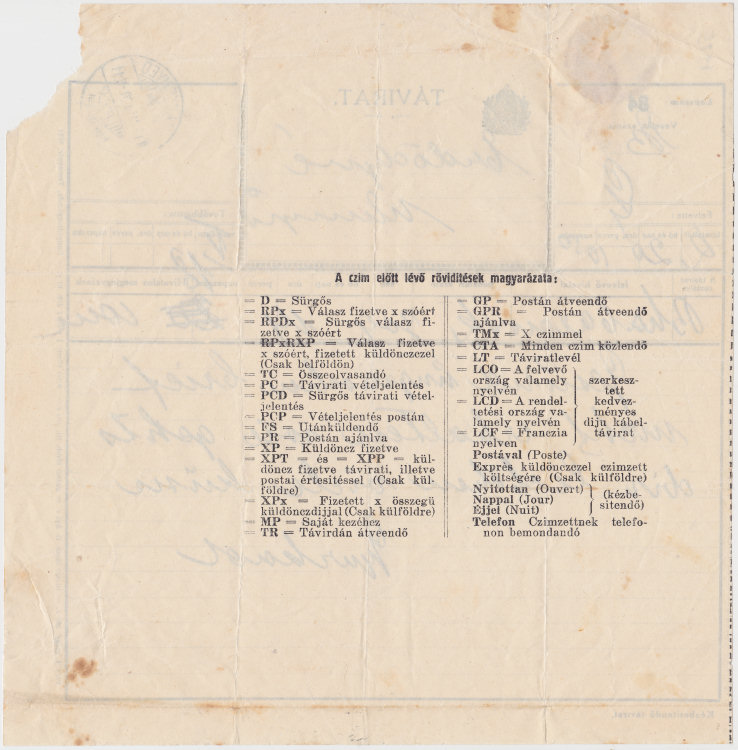

"Telegram to be delivered"

The long imprint up the right side starts with the date of 1914 and includes "Hunyadi-nyomda, Temesvár" (Hunyadi-printing house, Timisoara). It ends with "3781" ?
Timisoara is now in Banat, western Romania.
Another Bi-lingual form, used at Eszek or Osijek (now fourth largest city in Croatia). Undated.
On the back is "Kivánt Külőn kezelések jelzései: / Oznakc za posebno rukovanje: " meaning "Indications of desired treatments" in Hungarian and Croatian.
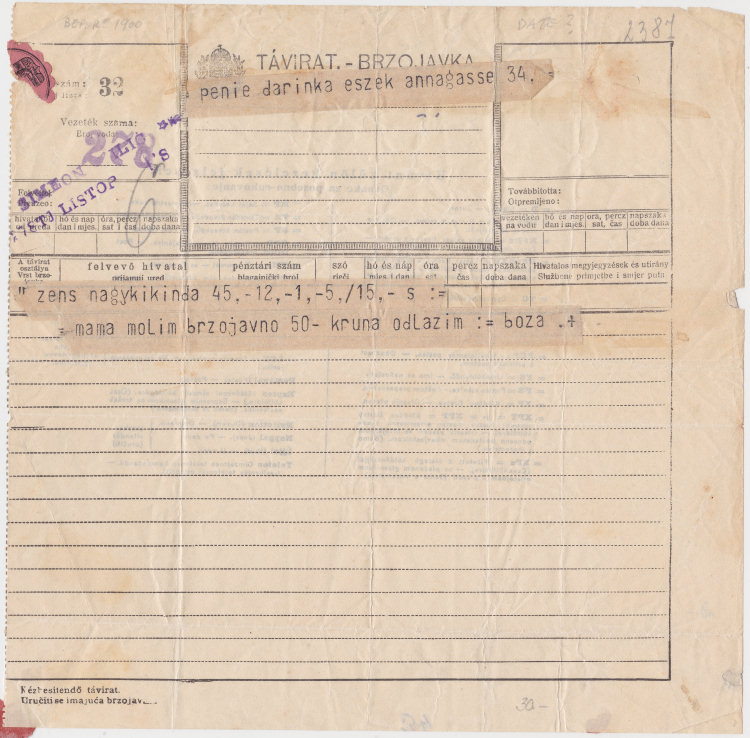
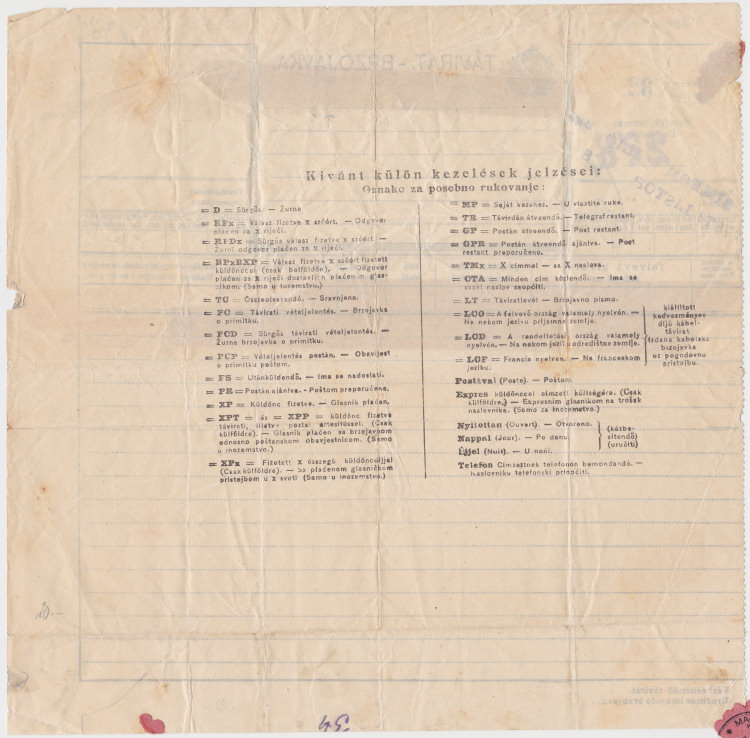

The bottom-left imprint "Kézbesitendö távirat. / Uručiti se imajuca brzojav." which is "Telegram to be delivered." in Hungarian at the top and Croatian at the bottom.
A Hungarian-only form printed 1914 and used 1915 in Nagy Szombat (now in Slovakia).
On the back is code list.
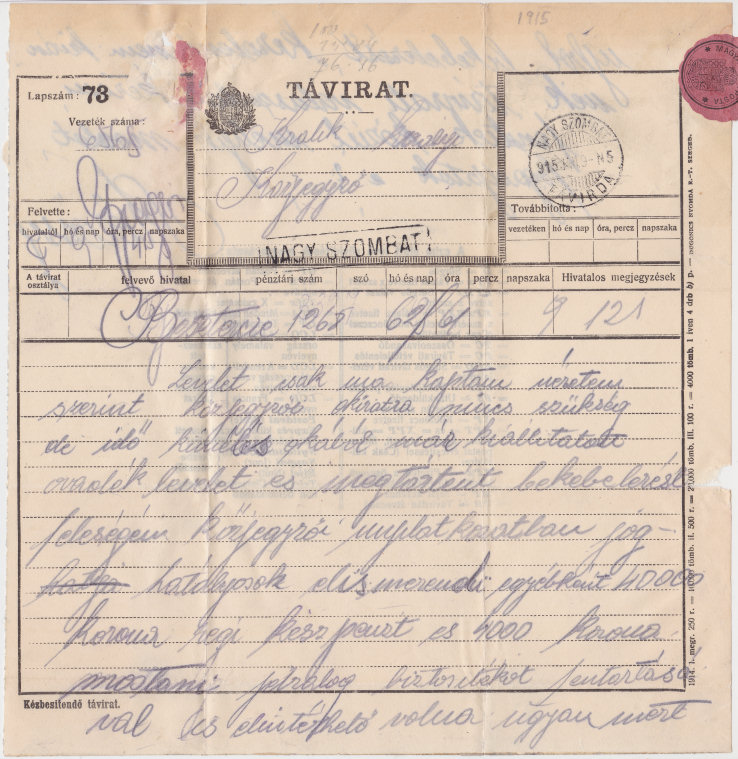
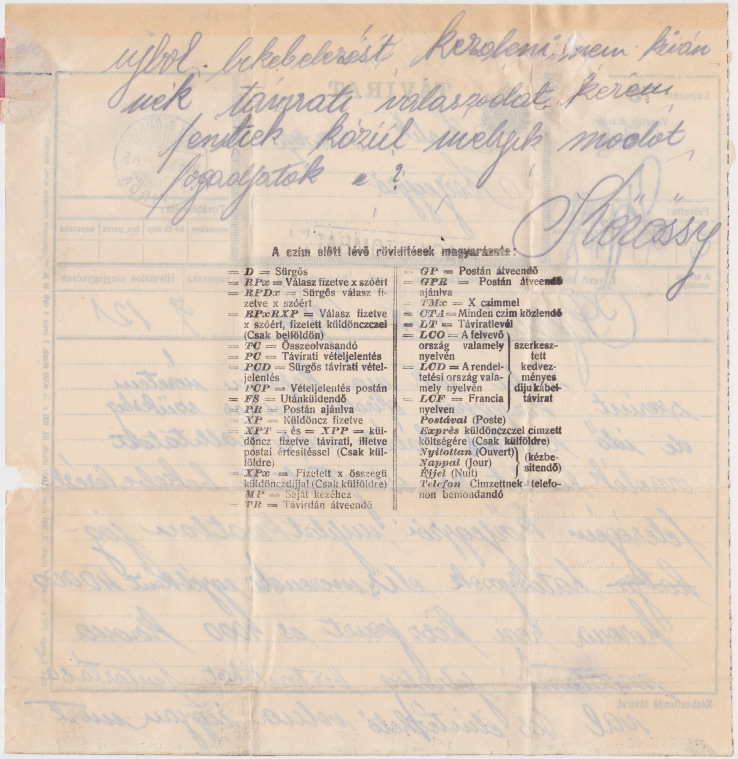

The usual "Kézbesitendö távirat" at the bottom. Long imprint up the right side starts with the date of 1914 and includes "DUGONICS NYOMDA R.-T. SZEGED." = DUGONICS printing company SZEGED.
Szeged is in southeastern Hungary.
A Bi-lingual version of the last form, printed in 1914 and used 5 May 1916.
No image of the back, but probably a bilingual version of the last code list.
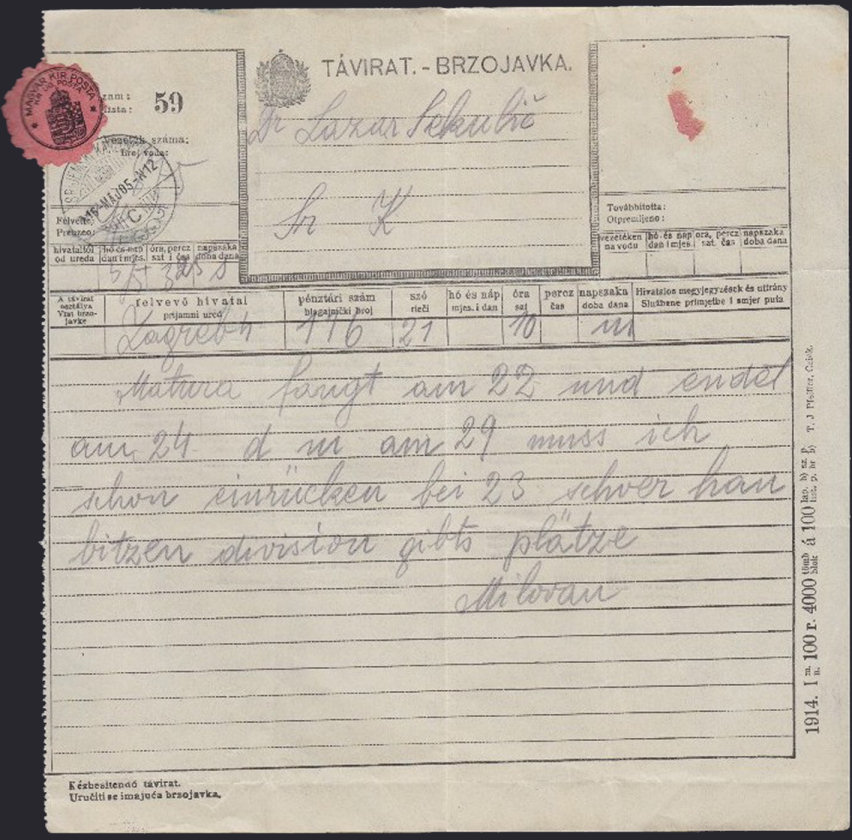
The imprint gives the year of 1914 and the printer name of T. J. Pfeiffers of Osiek (see 1896).

A very similar form to the last Hungarian-only form, except printed 1915 by a different printer, and used 1916 again in Nagy Szombat.
On the back is the code list.
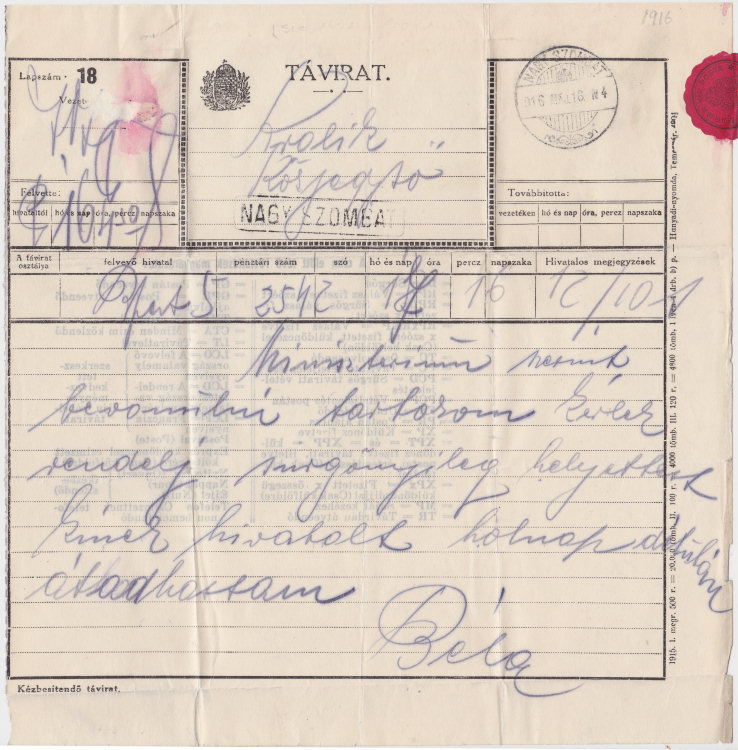
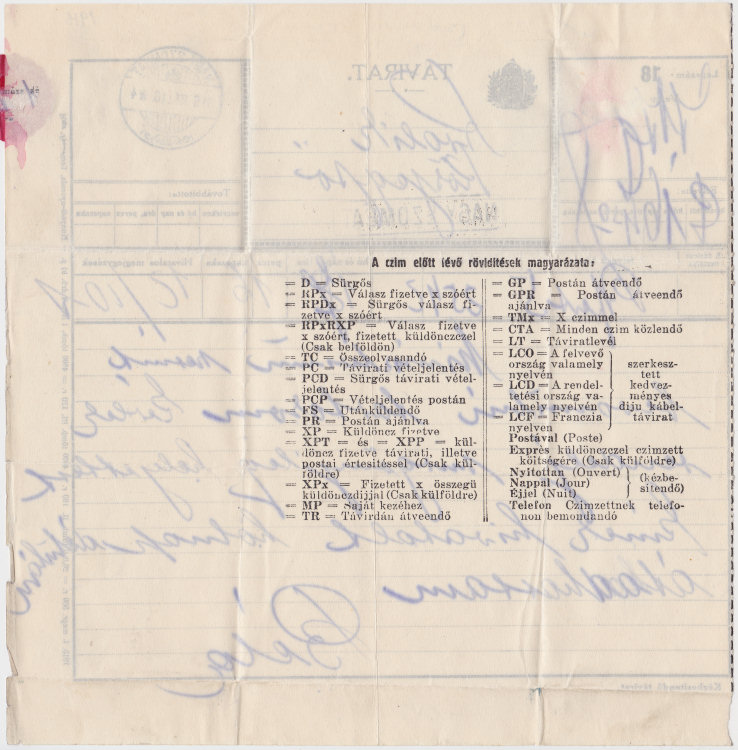

The usual "Kézbesitendö távirat" at the bottom. Long imprint up the right side starts with the date of 1915 and includes "Hunyadi-nyomda, Temesvár" (Hunyadi-printing house, Timisoara). It ends with "4904" ?
A similar form with 1914 imprint can be seen above.
A clearer image of the list :
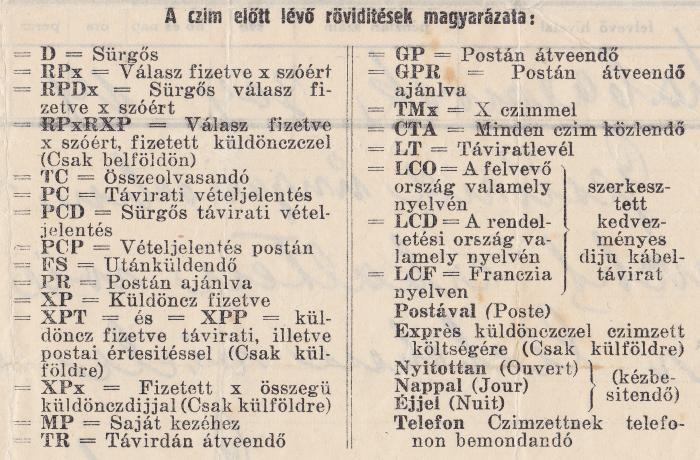
D = Sürgös = Urgent (from the French?), and forms part of other codes, so it makes sense to put it at the beginning.
RP is Reply Paid and is commonly used, but the rest seems to be in a rather arbitrary order.
Form 780, used 6 May 1918, in Bjelovar (now in Croatia). Bi-Lingual.
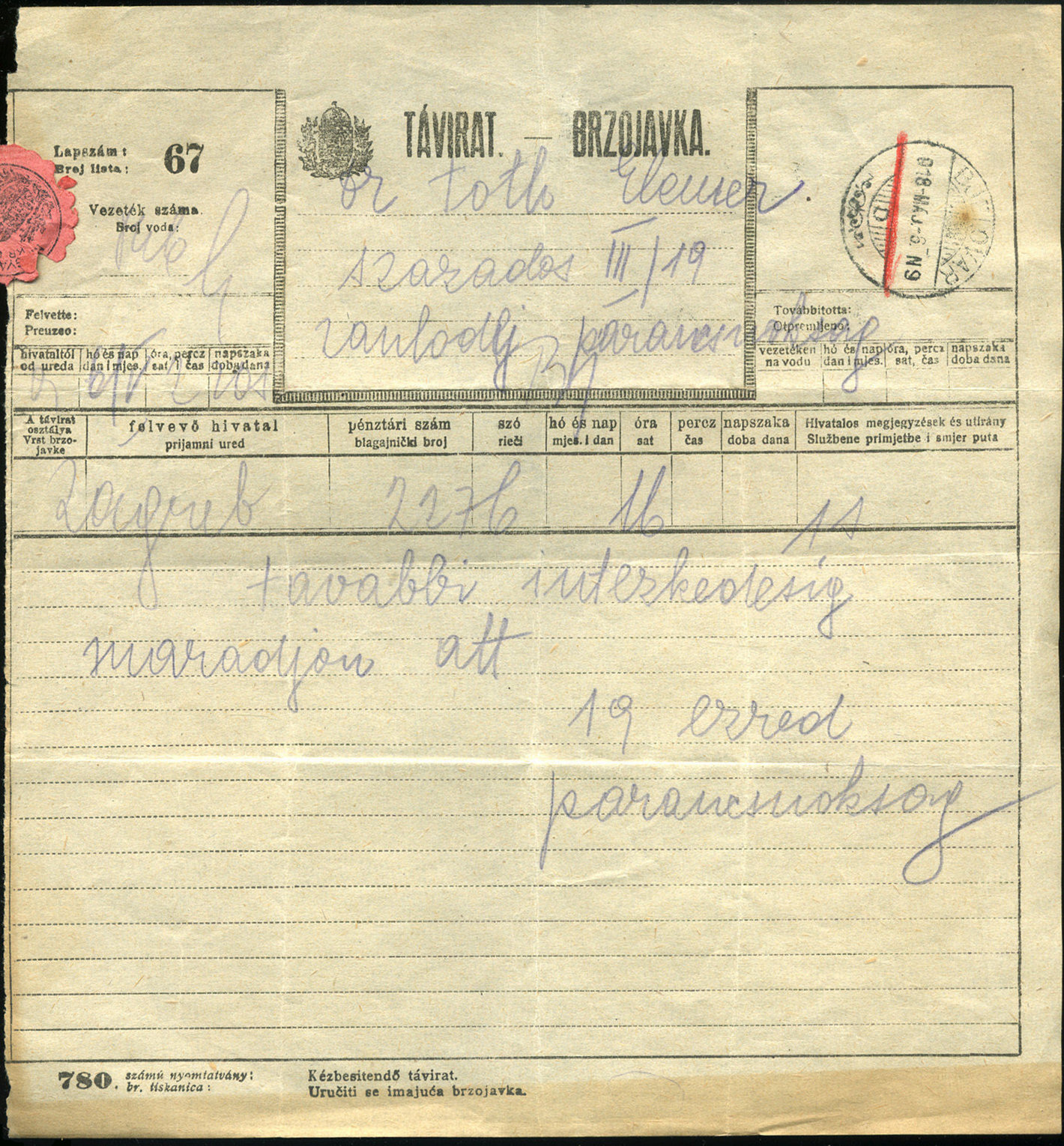
"780. form number: telegram to be delivered." is marked at the bottom in Hungarian and Croatian. No indication of who printed it.

Form 830, used 12 January 1944, in Ungvár (now in western Ukraine). Hungarian only.
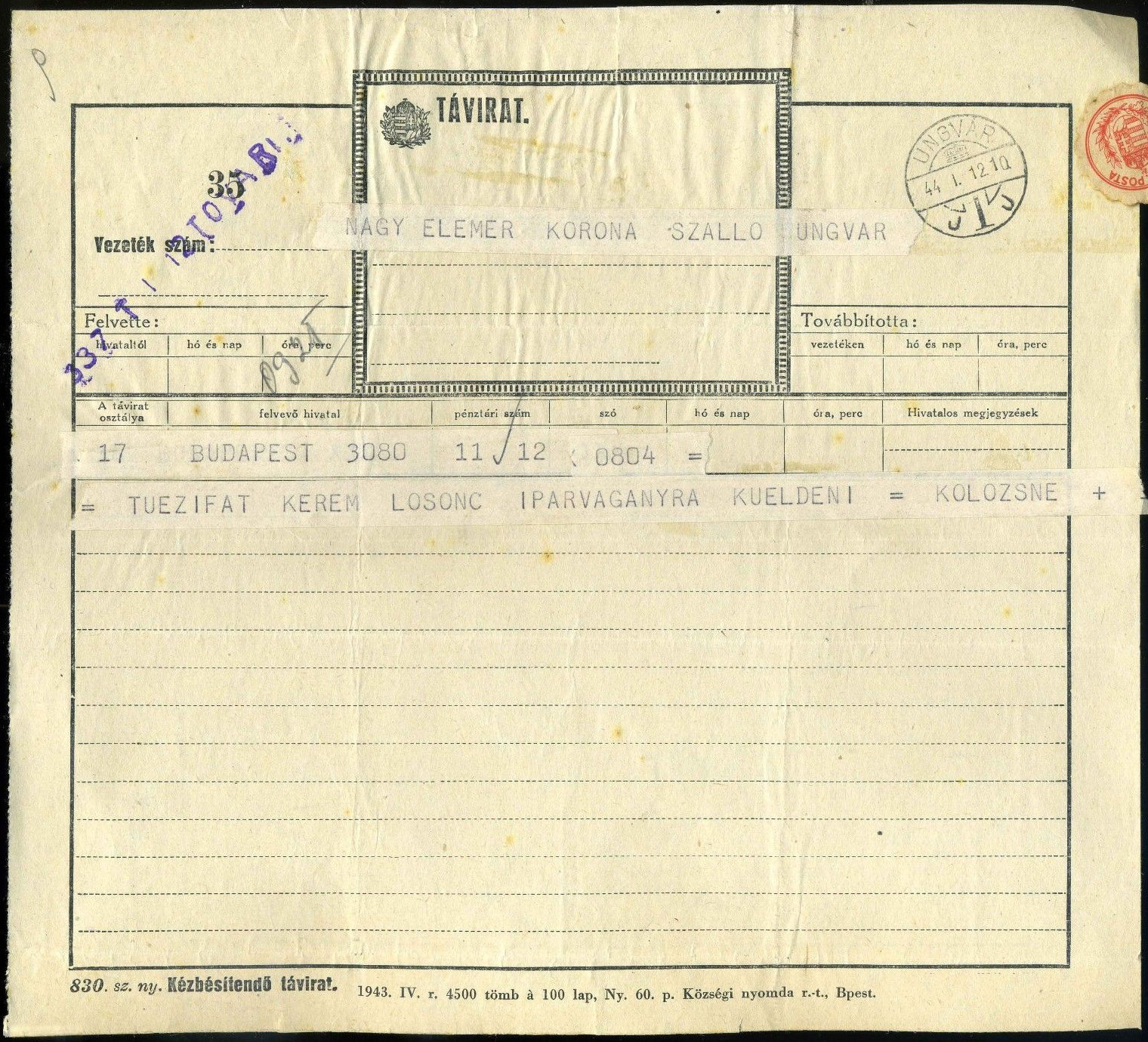
"830. sz[ámú] ny[omtatvány] Kézbesitendő távirat." = "830 form number telegram to be delivered." is marked at the bottom.

"Községi nyomda r[észvény]-t[ársaság.], Bpest." Indicates it was printed by the Municipal printing company, Budapest. (in 1943)
Telegraph Seals.
A range of different seals were used on telegrams in Hungary.
This half sized image shows a sample of them.

Steve Hiscocks made a start on cataloguing seals of the world in a book he published in 2007.
It was his hope to update it later, but unfortunately that was not to be.
His original book can be viewed at
Telegraph Seals: A World Catalogue. There are links from the pages to my updates.
Alternatively you can view the latest page for Hungary.
If anyone can provide scans to help with this, I am happy to give appropriate credit.
Comments, criticisms, information or suggestions are always welcome.

Please include the word 'Telegraphs' in the subject.
Last updated 19th. August 2025
©Copyright Steve Panting 2012/13/14/15/16/17/18/19/20/21/22/23/24/25 except where stated.
Permission is hereby granted to copy material for which the copyright is owned by myself, on condition that any data is not altered and this website is given credit.


